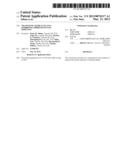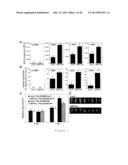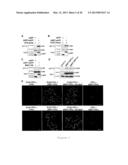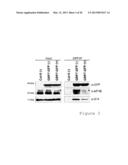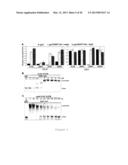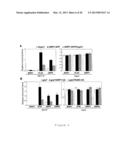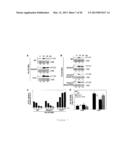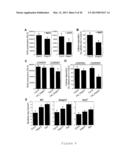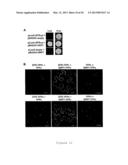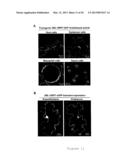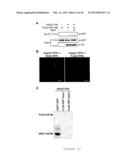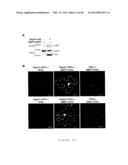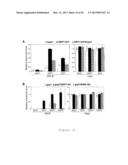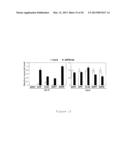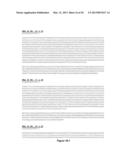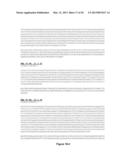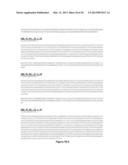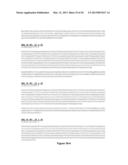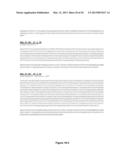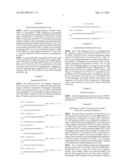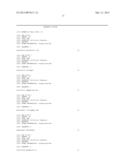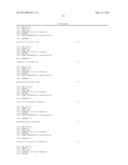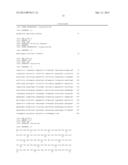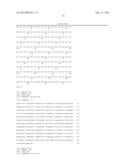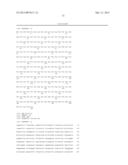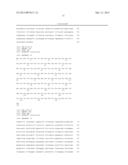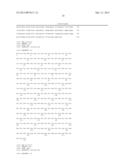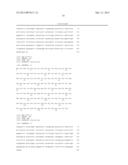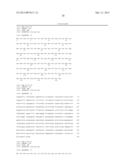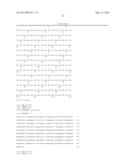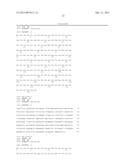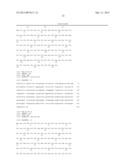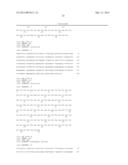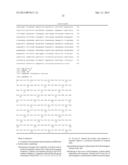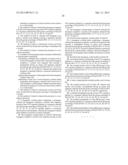Patent application title: TRANSGENIC SOYBEAN PLANTS EXHIBITING IMPROVED INNATE IMMUNITY
Inventors:
James R. Alfano (Lincoln, NE, US)
Anna Joe (Lincoln, NE, US)
Thomas E. Clemente (Lincoln, NE, US)
Zhengqing Fu (Cary, NC, US)
Ming Guo (Lincoln, NE, US)
Byeong-Ryool Jeong (Omaha, NE, US)
Thomas Elthon (Lincoln, NE, US)
IPC8 Class: AC12N1582FI
USPC Class:
800279
Class name: Multicellular living organisms and unmodified parts thereof and related processes method of introducing a polynucleotide molecule into or rearrangement of genetic material within a plant or plant part the polynucleotide confers pathogen or pest resistance
Publication date: 2013-03-21
Patent application number: 20130074217
Abstract:
This disclosure provides for compositions and methods to increase the
innate immunity of soybean plants.Claims:
1. A method of increasing the innate immunity exhibited by a soybean
plant comprising: introducing a transgene into a plurality of soybean
cells to produce transgenic soybean cells, wherein the transgene
comprises a nucleic acid sequence having at least 95% sequence identity
to a sequence selected from the group consisting of SEQ ID NO: 15, 17,
19, 21, 23, 25, 27, 29, 31, 33 and 35, wherein the nucleic acid sequence
is operably linked to a promoter functional in soybean cells;
regenerating transgenic soybean plants from the transgenic soybean cells;
and identifying at least one of said transgenic soybean plants expressing
said transgene, wherein said at least one of said transgenic soybean
plants exhibits increased innate immunity in response to at least one
biotic stress relative to a control plant.
2. The method of claim 1, wherein the transgene comprises a nucleic acid sequence having at least 99% sequence identity to a sequence selected from the group consisting of SEQ ID NO: 15, 17, 19, 21, 23, 25, 27, 29, 31, 33 and 35.
3. The method of claim 1, wherein said transgene comprises a nucleic acid sequence having a sequence selected from the group consisting of SEQ ID NO: 15, 17, 19, 21, 23, 25, 27, 29, 31, 33 and 35.
4. The method of claim 1, wherein the at least one biotic stress is selected from the group consisting of a pathogen and a wound.
5. The method of claim 1, wherein the promoter is a constitutive promoter.
6. A method of increasing the innate immunity exhibited by a soybean plant comprising: introducing a transgene into a plurality of soybean cells to produce transgenic soybean cells, wherein the transgene comprises a nucleic acid sequence that encodes a polypeptide having an amino acid sequence selected from the group consisting of SEQ ID NO: 16, 18, 20, 22, 24, 26, 28, 30, 32, 34 and 36, wherein the nucleic acid sequence is operably linked to a promoter functional in soybean cells; regenerating transgenic soybean plants from the transgenic soybean cells; and identifying at least one of said transgenic soybean plants expressing said transgene, wherein said at least one of said transgenic soybean plants exhibits increased innate immunity in response to at least one biotic stress relative to a control plant.
7. The method of claim 6, wherein the at least one biotic stress is selected from the group consisting of a pathogen and a wound.
8. The method of claim 6, wherein the promoter is a constitutive promoter
9. A transgenic soybean plant comprising a transgene, wherein the transgene comprises a nucleic acid sequence having at least 95% sequence identity to a sequence selected from the group consisting of SEQ ID NO: 15, 17, 19, 21, 23, 25, 27, 29, 31, 33 and 35 operably linked to a promoter functional in soybean plants, wherein the transgenic soybean plant exhibits an increase in innate immunity.
10. The transgenic soybean plant of claim 9, wherein the transgene comprise a nucleic acid sequence having at least 99% sequence identity to a sequence selected from the group consisting of SEQ ID NO: 15, 17, 19, 21, 23, 25, 27, 29, 31, 33 and 35.
11. The transgenic soybean plant of claim 9, wherein the transgene comprises a nucleic acid sequence selected from the group consisting of SEQ ID NO: 15, 17, 19, 21, 23, 25, 27, 29, 31, 33 and 35.
12. Seed from the transgenic soybean plant of claim 9.
13. A transgenic soybean plant comprising a transgene, wherein the transgene comprises a nucleic acid sequence that encodes a polypeptide having an amino acid sequence selected from the group consisting of SEQ ID NO: 16, 18, 20, 22, 24, 26, 28, 30, 32, 34 and 36 operably linked to a promoter functional in soybean plants, wherein, when the transgene is expressed, the transgenic plant exhibits an increase in innate immunity.
14. Seed from the transgenic soybean plant of claim 13.
15. An isolated nucleic acid having at least 95% sequence identity to a sequence selected from the group consisting of SEQ ID NO: 15, 17, 19, 21, 23, 25, 27, 29, 31, 33 and 35.
16. The isolated nucleic acid of claim 15 having at least 99% sequence identity to a sequence selected from the group consisting of SEQ ID NO: 15, 17, 19, 21, 23, 25, 27, 29, 31, 33 and 35.
17. The isolated nucleic acid of claim 15 having a sequence selected from the group consisting of SEQ ID NO: 15, 17, 19, 21, 23, 25, 27, 29, 31, 33 and 35.
18. A vector comprising the isolated nucleic acid of claim 15.
19. The isolated nucleic acid of claim 15, wherein said nucleic acid encodes a polypeptide having an amino acid sequence selected from the group consisting of SEQ ID NO: 16, 18, 20, 22, 24, 26, 28, 30, 32, 34 and 36, respectively.
20. A purified polypeptide having at least 95% sequence identity to a sequence selected from the group consisting of SEQ ID NO: 16, 18, 20, 22, 24, 26, 28, 30, 32, 34 and 36.
21. The purified polypeptide of claim 20 having at least 99% sequence identity to a sequence selected from the group consisting of SEQ ID NO: 16, 18, 20, 22, 24, 26, 28, 30, 32, 34 and 36.
22. The purified polypeptide of claim 20 having a sequence selected from the group consisting of SEQ ID NO: 16, 18, 20, 22, 24, 26, 28, 30, 32, 34 and 36.
Description:
CROSS REFERENCE TO RELATED APPLICATIONS
[0001] This application claims benefit under 35 U.S.C. 119(e) to U.S. Application No. 61/532,526 filed Sep. 8, 2011, the entirety of which is incorporated by reference herein.
TECHNICAL FIELD
[0002] This disclosure generally relates to soybean plants that have been genetically-engineered to improve their innate immunity.
BACKGROUND
[0003] The phytopathogenic bacterium, Pseudomonas syringae, can suppress both pathogen-associated molecular pattern (PAMP)-triggered immunity (PTI) and effector-triggered immunity (ETI) by the injection of type III effector (T3E) proteins into host cells. T3Es achieve immune suppression using a variety of strategies including interference with immune receptor signaling, blocking RNA pathways and vesicle trafficking, and altering organelle function.
[0004] Based, at least in part on the experimental results described herein, this disclosure provides compositions and methods that can be used to genetically engineer plants (e.g., soybean plants) that are able to exploit this interaction, thereby increasing the innate immunity of the plants.
SUMMARY
[0005] In one aspect, a method of increasing the innate immunity exhibited by a soybean plant is provided. Such a method typically includes introducing a transgene into a plurality of soybean cells to produce transgenic soybean cells, wherein the transgene comprises a nucleic acid sequence having at least 95% sequence identity to a sequence selected from the group consisting of SEQ ID NO: 15, 17, 19, 21, 23, 25, 27, 29, 31, 33 and 35, wherein the nucleic acid sequence is operably linked to a promoter functional in soybean cells; regenerating transgenic soybean plants from the transgenic soybean cells; and identifying at least one of the transgenic soybean plants expressing the transgene. Generally, the at least one of the transgenic soybean plants exhibits increased innate immunity in response to at least one biotic stress relative to a control plant.
[0006] In one embodiment, the transgene comprises a nucleic acid sequence having at least 99% sequence identity to a sequence selected from the group consisting of SEQ ID NO: 15, 17, 19, 21, 23, 25, 27, 29, 31, 33 and 35. In another embodiment, the transgene comprises a nucleic acid sequence having a sequence selected from the group consisting of SEQ ID NO: 15, 17, 19, 21, 23, 25, 27, 29, 31, 33 and 35. In some embodiments, the at least one biotic stress includes a pathogen such as, without limitation, bacteria, fungi, protozoa a virus, an insect, or a wound such as, without limitation, physical damage caused by people. In some embodiments, the promoter is a constitutive promoter.
[0007] In another aspect, a method of increasing the innate immunity exhibited by a soybean plant is provided. Such a method typically includes introducing a transgene into a plurality of soybean cells to produce transgenic soybean cells, wherein the transgene comprises a nucleic acid sequence that encodes a polypeptide having an amino acid sequence selected from the group consisting of SEQ ID NO: 16, 18, 20, 22, 24, 26, 28, 30, 32, 34 and 36, wherein the nucleic acid sequence is operably linked to a promoter functional in soybean cells; regenerating transgenic soybean plants from the transgenic soybean cells; and identifying at least one of the transgenic soybean plants expressing the transgene. Generally, the at least one of the transgenic soybean plants exhibits increased innate immunity in response to at least one biotic stress relative to a control plant.
[0008] In some embodiments, the at least one biotic stress includes a pathogen such as, without limitation, bacteria, fungi, protozoa a virus, and an insect, or a wound such as, without limitation, physical damage caused by people. In some embodiments, wherein the promoter is a constitutive promoter
[0009] In still another aspect, a transgenic soybean plant comprising a transgene is provided. Typically, the transgene comprises a nucleic acid sequence having at least 95% sequence identity to a sequence selected from the group consisting of SEQ ID NO: 15, 17, 19, 21, 23, 25, 27, 29, 31, 33 and 35 operably linked to a promoter functional in soybean plants. Generally, the transgenic soybean plant exhibits an increase in innate immunity.
[0010] In some embodiments, the transgene comprise a nucleic acid sequence having at least 99% sequence identity to a sequence selected from the group consisting of SEQ ID NO: 15, 17, 19, 21, 23, 25, 27, 29, 31, 33 and 35. In some embodiments, the transgene comprises a nucleic acid sequence selected from the group consisting of SEQ ID NO: 15, 17, 19, 21, 23, 25, 27, 29, 31, 33 and 35. Also provided is seed from such a transgenic plant.
[0011] In yet another aspect, a transgenic soybean plant comprising a transgene is provided. Typically, the transgene comprises a nucleic acid sequence that encodes a polypeptide having an amino acid sequence selected from the group consisting of SEQ ID NO: 16, 18, 20, 22, 24, 26, 28, 30, 32, 34 and 36 operably linked to a promoter functional in soybean plants. Generally, the transgenic soybean plant exhibits an increase in innate immunity. Also provided is seed from such a transgenic plant.
[0012] In another aspect, an isolated nucleic acid having at least 95% sequence identity to a sequence selected from the group consisting of SEQ ID NO: 15, 17, 19, 21, 23, 25, 27, 29, 31, 33 and 35 is provided. In some embodiments, the isolated nucleic acid has at least 99% sequence identity to a sequence selected from the group consisting of SEQ ID NO: 15, 17, 19, 21, 23, 25, 27, 29, 31, 33 and 35. In some embodiments, the isolated nucleic acid has a sequence selected from the group consisting of SEQ ID NO: 15, 17, 19, 21, 23, 25, 27, 29, 31, 33 and 35. Also provided is a vector comprising such an isolated nucleic acid. In some embodiments, the isolated nucleic acid encodes a polypeptide having an amino acid sequence selected from the group consisting of SEQ ID NO: 16, 18, 20, 22, 24, 26, 28, 30, 32, 34 and 36, respectively.
[0013] In still another aspect, a purified polypeptide is provided. Such a polypeptide typically has at least 95% sequence identity to a sequence selected from the group consisting of SEQ ID NO: 16, 18, 20, 22, 24, 26, 28, 30, 32, 34 and 36. In some embodiments, the purified polypeptide has at least 99% sequence identity to a sequence selected from the group consisting of SEQ ID NO: 16, 18, 20, 22, 24, 26, 28, 30, 32, 34 and 36. In some embodiments, the purified polypeptide has a sequence selected from the group consisting of SEQ ID NO: 16, 18, 20, 22, 24, 26, 28, 30, 32, 34 and 36.
[0014] Unless otherwise defined, all technical and scientific terms used herein have the same meaning as commonly understood by one of ordinary skill in the art to which the methods and compositions of matter belong. Although methods and materials similar or equivalent to those described herein can be used in the practice or testing of the methods and compositions of matter, suitable methods and materials are described below. In addition, the materials, methods, and examples are illustrative only and not intended to be limiting. All publications, patent applications, patents, and other references mentioned herein are incorporated by reference in their entirety.
DESCRIPTION OF DRAWINGS
[0015] FIG. 1 shows that GRP7 overexpression enhances significantly PTI responses and resistance to Pseudomonas infection. Panel (A) shows the oxidative burst triggered by 1 μM flg22, 1 μM elf18, 100 μg/mL chitin or in the absence of PAMP treatment in Col-2 and transgenic A. thaliana plants overexpressing GRP7 (GRP7ox). ROS production is presented as total photon count during 25 min of treatment and measured in relative light units (RLU). Values are mean±SE (n=6). Statistical significance was assessed using the ANOVA test (P<0.001). Panel (B) shows callose deposition induced by 1 μM flg22, 1 μM elf18, 100 μg/mL chitin or in the absence of PAMP treatment, directly infiltrated in Col-2 and transgenic A. thaliana plants overexpressing GRP7 (GRP7ox). Values are mean±SE (n=24). Statistical significance was assessed using the ANOVA test (P<0.001). ND, non detectable. Panel (C) shows the growth of Pseudomonas syringae pv. tomato (Pto) DC3000 on Col-2 and GRP7ox plants as measured by colony forming units (cfu). Bacterial growth was measured four days after spray-inoculation with the wild-type strain (WT) or the hrcC.sup.+ strain. Values are mean±SE (n=4). dai, days after-inoculation. Statistical significance was assessed using the ANOVA test (P<0.001). Panel (D) shows the disease symptoms on Col-2 and GRP7ox plants, four days after spray-infection with Pto DC3000 WT. All results shown are representative of at least three independent experiments.
[0016] FIG. 2 shows that GRP7 associates with FLS2 at the plasma membrane. Panels (A-C) shows the co-immunoprecipitation assay performed after transient co-expression of GRP7-eGFP or eGFP with EFR-3×HA (A), FLS2-3×myc (B) or BAK1-HA (C) in N. benthamiana plants. Total proteins (input) were subjected to immunoprecipitation with GFP Trap beads followed by immunoblot analysis. Panel (D) shows the co-immunoprecipitation of GRP7 and FLS2 in A. thaliana. Co-immunoprecipitation assay performed on Col-0 and GRP7-GFP plants untreated (-) or treated (+) with 1 μM flg22 for 15 min. Total proteins (input) were subjected to immunoprecipitation with GFP Trap beads followed by immunoblot analysis. Panel (E) shows the bimolecular fluorescence complementation assays between GRP7 and FLS2. YFPn, GRP7-YFPn, YFPc and FLS2-YFPc, as well as the reverse combinations YFPc, GRP7-YFPc, YFPn and FLS2-YFPn, were transiently co-expressed in N. benthamiana leaves. Plasmolysis experiment was performed in the presence of 5% NaCl for 5 min. Arrows indicate Hechtian strands. Scale bar corresponds to 20 μm. Photographs were taken 2 days after infiltration and are representative of the total observations (n=60). All results shown are representative of three independent experiments.
[0017] FIG. 3 shows that GRP7 associates with translational components in Arabidopsis. Co-immunoprecipitation assay performed on Col-0 and GRP7-GFP plants untreated (-) or treated (+) with 1 μM flg22 for 15 min. Total proteins (input) were subjected to immunoprecipitation with GFP Trap beads followed by immunoblot analysis with anti-GFP antibodies to detect GRP7-GFP or specific antibodies recognizing the translation initiation factor eIF4E and the ribosomal protein S14. Asterisks mark eIF4E slower-migrating bands. The results shown are representative of three independent experiments.
[0018] FIG. 4 shows that HopU1 does not affect the protein-protein interactions between GRP7, FLS2 and translational components. Co-immunoprecipitation assay performed on Col-0 and HopU1 Arabidopsis plants expressing or not GRP7-GFP. Total proteins (input) were subjected to immunoprecipitation with GFP Trap beads followed by immunoblot analysis with anti-GFP antibodies to detect GRP7 or specific antibodies recognizing FLS2, the translation initiation factor eIF4E, or the ribosomal protein S14. Asterisks mark slower-migrating bands forms. The results shown are representative of three independent experiments.
[0019] FIG. 5 shows that GRP7 binds FLS2 transcript. Panel (A) shows RNA immunoprecipitation in grp7-1 and grp7-1/GRP7-HA A. thaliana lines treated for 30 min with water or 1 μM flg22. Total proteins were subjected to immunoprecipitation with anti-HA antibodies followed by quantitative RT-PCR analysis of FLS2, BAK1, GRP7 and GRP8 transcripts with specific primers. Values are mean±SE (n=4). The results shown are representative of three independent experiments. Panels (B) and (C) show that GRP7 binds the 3'UTR of FLS2 transcripts in vitro. Electrophoretic shift assays performed on the 3'UTR of FLS2 RNAs, in presence of increasing concentrations of GRP7-GST (B). Competition assay were performed with increasing quantity of unlabeled FLS2 3'UTR transcripts to GRP7-GST and 32P-labeled FLS2 3'UTR transcripts (C). The results shown are representative of three independent experiments.
[0020] FIG. 6 shows that HopU1 disrupts GRP7-FLS2 transcripts interactions. Panel (A) shows RNA immunoprecipitation in HopU1, GRP7-GFP and GRP7-GFP/HopU1 A. thaliana lines. Total proteins were subjected to immunoprecipitation with GFP Trap beads followed by quantitative RT-PCR analysis of BAK1, FLS2 and GRP7 transcripts with specific primers. Values are mean±SE (n=4). Panel (B) shows RNA immunoprecipitation in grp7, grp7/GRP7-HA and grp7/GRP7(R49K)-HA A. thaliana lines. Total proteins were subjected to immunoprecipitation with anti-HA matrix beads followed by quantitative RT-PCR analysis of BAK1, FLS2, GRP7 and GRP8 transcripts with specific primers. Values are mean±SE (n=4). The results shown are representative of three independent experiments.
[0021] FIG. 7 shows that HopU1 inhibits FLS2 protein accumulation during infection. Panel (A) shows immunoblots with specific antibodies detecting endogenous FLS2 in Col-0 during bacterial infection after syringe-inoculation with Pto DC3000 (WT; inoculum: 5×107 cfu/mL), Pto DC3000 ΔhopU1 (inoculum: 108 cfu/mL), Pto DC3000 hrcC.sup.+ (inoculum: 108 cfu/mL). hpi, hours post-infection; CBB, Coomassie Brilliant Blue. Values correspond to signal intensity of the FLS2-specific band from the immunoblots relative to the zero time-point. Panel (B) shows immunoblots with specific antibodies detecting endogenous FLS2 in Col-0 during bacterial infection after syringe-inoculation with Pto DC3000 (WT; inoculum: 5×107 cfu/mL), Pto DC3000 ΔhopU1 (inoculum: 108 cfu/mL), Pto DC3000 ΔhopU1 [HopU1] (inoculum: 108 cfu/mL), Pto DC3000 ΔhopU1 [HopU1DD] (inoculum: 108 cfu/mL). hpi, hours post-infection; CBB, Coomassie Brilliant Blue. Values correspond to signal intensity of the FLS2-specific band from the immunoblots relative to the zero time-point. Panel (C) shows the FLS2 transcript level as measured by quantitative RT-PCR in Col-0 plants during bacterial infection after syringe-inoculation with Pto DC3000 (WT; inoculum: 5×107 cfu/mL), Pto DC3000 ΔhopU1 (inoculum: 108 cfu/mL), Pto DC3000 hrcC.sup.+ (inoculum: 108 cfu/mL). hpi, hours post-infection. Panel (D) shows bacteria growth measured during pseudomonas infection in Col-0 plants, after syringe- (inoculum: 2×105 cfu/mL) or spray-inoculation (inoculum: 2×108 cfu/mL) with Pto DC3000 wild-type (WT) or the derivated strains ΔfliC, ΔhopU1 and ΔhopU1ΔfliC. Growth measured by colony forming units (cfu) two and/or four days after inoculation. Values are mean±SE (n=4). Statistical significance was assessed using the ANOVA test (P<0.001). dai, days after-inoculation. The results shown are representative of three independent experiments.
[0022] FIG. 8 shows GRP7 over-expression in the GRP7ox line. Immunoblots with a specific antibody detecting GRP7 in Col-2 and the transgenic Arabidopsis thaliana line overexpressing GRP7 (GRP7ox). The blot obtained with the antibody anti-LHCP (Light Harvesting Chlorophyll a/b Protein) served as a loading control.
[0023] FIG. 9 shows that HopU1 suppresses early and late immune responses triggered by flg22 in Arabidopsis. Panel (A) shows the oxidative burst triggered by 50 nM flg22 or 50 nM elf18 in Col-0 and transgenic A. thaliana plants expressing HopU1-HA under 35S promoter (HopU1). ROS production is presented as total photon count during 40 min of treatment and measured in relative light units (RLU). Values are mean±SE (n=12). Statistical significance was assessed using the ANOVA test (P<0.001). Panel (B) shows callose deposition induced by 1 μM flg22 infiltrated in Col-0 and transgenic A. thaliana plants expressing HopU1-HA under 35S promoter (HopU1). Values are mean±SE (n=10). Statistical significance was assessed using the ANOVA test (P<0.001). Panel (C) shows the oxidative burst triggered by 50 nM flg22 in Col-0 and transgenic A. thaliana plants expressing HopU1-HA under the control of an estradiol-inducible promoter (ind_HopU1), with or without a 15 μM β-estradiol pre-treatment. ROS production is presented as total photon count during 40 min of treatment and measured in relative light units (RLU). Values are mean±SE (n=12). Statistical significance was assessed using the ANOVA test (P<0.001). Panel (D) shows callose deposition induced by 1 μM flg22 infiltrated in Col-0 and transgenic A. thaliana plants expressing HopU1-HA under the control of an estradiol-inducible promoter (ind_HopU1), with or without a 15 μM β-estradiol pre-treatment. Values are mean±SE (n=10). Statistical significance was assessed using the ANOVA test (P<0.001). Panel (E) shows the growth of Pseudomonas syringae pv. tomato (Pto) DC3000 on Col-0, HopU1 (35S::HopU1-HA) and fls2 plants as measured by colony forming units (cfu). Bacterial growth was measured three days after spray-inoculation with wild-type Pto DC3000 (WT; inoculum: 106 cfu/mL), Pto DC3000 ΔhopU1 (inoculum: 108 cfu/mL) and Pto DC3000 hrcC.sup.+ (inoculum: 108 cfu/mL). Values are mean±SE (n=4). Statistical significance was assessed using the ANOVA test (P<0.05). All results shown are representative of at least three independent experiments.
[0024] FIG. 10 shows that GRP7 interacts with EFR at the plasma membrane. Panel (A) shows that EFR and GRP7 interact in yeast two-hybrid assays. The cytoplasmic part of EFR (EFRcyt) has been found to interact with GRP7 during a yeast two-hybrid screen and confirmed upon expression of pLexA-EFRcyt and pB42AD-GRP7. Interaction assays were performed in presence or absence of the auxotrophic amino acid leucine (Leu). Panel (B) shows the bimolecular fluorescence complementation assays between GRP7 and EFR. YFPn, GRP7-YFPn, YFPc and EFR-YFPc, as well as the reverse combinations YFPc, GRP7-YFPc, YFPn and EFR-YFPn, were transiently co-expressed in N. benthamiana leaves. Scale bar corresponds to 20 μm. Photographs were taken 2 days after infiltration and are representative of the total observations (n=60). All results shown are representative of three independent experiments.
[0025] FIG. 11 shows GRP7 sub-cellular localization. Panel (A) shows GRP7 sub-cellular localisation in the stable transgenic on A. thaliana plants 35S::GRP7-GFP line as observed by confocal microscopy. Panel (B) shows the localization of GRP7-eGFP transiently expressed in N. benthamiana and N. tabacum as observed by confocal microscopy.
[0026] FIG. 12 shows that HopU1 does not interact with, nor ADP-ribosylates, FLS2 protein. Panel (A) shows the co-immunoprecipitation assay performed after transient co-expression of HopU1-HA and FLS2-GFP-His on N. benthamiana plants, with (+) or without (-) treatment of the samples with 1 μM flg22 for 15 min. Total proteins (input) were subjected to immunoprecipitation with anti-HA beads followed by immunoblot analysis. Panel (B) shows the bimolecular fluorescence complementation assays between HopU1 and FLS2. HopU1-YFPn and FLS2-YFPc, as well as the opposite combination HopU1-YFPc and FLS2-YFPn, were transiently co-expressed N. benthamiana leaves. Scale bar corresponds to 20 μm. Photographs were taken 2 days after infiltration and are representative of the total observations (n=60). Panel (C) shows the in vitro ADP-ribosylation assay performed with recombinant FLS2-GST and HopU1-His on supernatant (sup) and pellet (pell) fractions. The reaction between GRP7-GST and HopU1-His has been included as a positive control. All results shown are representative of three independent experiments.
[0027] FIG. 13 shows that GRP7 interacts with HopU1 in the cytoplasm and in the nucleus. Panel (A) shows the co-immunoprecipitation of GRP7 and HopU1. GRP7-eGFP and HopU1-HA were transiently co-expressed in N. benthamiana leaves. Total proteins (input) were subjected to immunoprecipitation with anti-HA beads followed by immunoblot analysis with anti-GFP antibodies to detect GRP7-eGFP. Panel (B) shows the bimolecular fluorescence complementation assays between GRP7 and HopU1. GRP7-YFPn/c and HopU1-YFPc/n were transiently co-expressed in N. benthamiana leaves. Scale bar corresponds to 20 μm. Photographs were taken 2 days after infiltration and are representative of the total observations (n=60). All results shown are representative of three independent experiments.
[0028] FIG. 14 shows that HopU1 disrupts GRP7-EFR transcript interactions. Panel (A) shows RNA immunoprecipitation in HopU1-HA, GRP7-GFP and GRP7-GFP/HopU1-HA A. thaliana lines. Total proteins were subjected to immunoprecipitation with GFP Trap beads followed by quantitative RT-PCR analysis of BAK1, EFR, and GRP7 transcripts with specific primers. Values are mean±SE (n=4). Panel (B) shows RNA immunoprecipitation in grp7, grp7/GRP7-HA and grp7/GRP7(R49K)-HA A. thaliana lines. Total proteins were subjected to immunoprecipitation with anti-HA matrix beads followed by quantitative RT-PCR analysis of BAK1, EFR, GRP7 and GRP8 transcripts with specific primers. Values are mean±SE (n=4).
[0029] FIG. 15 shows that GRP8 binds FLS2 and EFR transcripts. RNA immunoprecipitation in Col-0 and GRP8-HA A. thaliana lines. Total proteins were subjected to immunoprecipitation with anti-HA beads followed by quantitative RT-PCR analysis of BAK1, EFR, FLS2, GRP7 and GRP8 transcripts with specific primers. Values are mean±SE (n=4).
[0030] FIG. 16 shows the nucleic acid and amino acid sequences of the soybean genes described herein. The A. thaliana GRP7 sequences also are shown.
DETAILED DESCRIPTION
[0031] HopU1, a mono-ADP-ribosyltransferase (ADP-RT) from the pathogen, P. syringae, modifies GRP7, an RNA-binding protein in the plant. Native GRP7 binds to FLS2 and EFR RNA, but this binding is reduced when GRP7 is ribosylated at Arg 49 (R49). In addition, plants lacking GRP7 indicate that GRP7 plays a role in innate immunity. See, for example, Fu et al., 2007, Nature, 447:284-8; and Jeong et al., 2011, J. Biol. Chem., 286:43272-81.
[0032] In order to increase the innate immunity of an agricultural crop, soybean sequences were identified that have a significant amount of homology to GRP7. These sequences were cloned and introduced into soybean plants, and their effect on innate immunity was evaluated. Innate immunity also is known as non-specific immunity and recognize and respond to pathogens immediately but does not confer long-lasting immunity to the host. Representative examples of biotic stresses include, without limitation, pathogens (e.g., bacteria, fungi, protozoa viruses, insects) or a physical lesion or wound.
Nucleic Acids and Polypeptides
[0033] The sequences identified in soybean have the nucleic acid sequences shown in SEQ ID NOs: 15, 17, 19, 21, 23, 25, 27, 29, 31, 33 and 35. The term "nucleic acid" refers to a deoxyribonucleic acid or a ribonucleic acid in single- or double-stranded form, sense or anti-sense, and, unless otherwise indicated, encompasses known analogues of natural nucleotides that hybridize to nucleic acids in a manner similar to naturally occurring nucleotides. Unless otherwise indicated, a particular nucleic acid sequence includes the complementary sequence thereof. The term "operably linked" refers to functional linkage between a nucleic acid expression control sequence (such as a promoter, signal sequence, or transcription factor binding sites) and a coding nucleic acid sequence, wherein the expression control sequence affects transcription and/or translation of the coding nucleic acid sequence.
[0034] Alignment of two or more sequences may be conducted, for example, using any number of methods (e.g., the local homology algorithm of Smith and Waterman (1981, Adv. Appl. Math. 2:482), the homology alignment algorithm of Needleman and Wunsch (1970, J. Mol. Biol. 48:443), the search for similarity method of Pearson and Lipman (1988, PNAS USA, 85:2444), computerized implementations of these algorithms (GAP, BESTFIT, FASTA, and TFASTA, as provided by, for example, the Wisconsin Genetics Software Package, Genetics Computer Group, Madison, Wis.) or inspection). The preferred method of alignment uses the Basic Local Alignment Search Tool (BLAST) (Altschul et al., 1990, J. Mol. Biol., 215:403-10) available from ncbi.nlm.nih.gov on the World Wide Web.
[0035] The term "percent sequence identity" as applied to an amino acid sequence refers to a polypeptide that has at least 70% sequence identity (e.g., at least 80%, 90%, 95%, 99% or 100% sequence identity) compared to another amino acid sequence (e.g., SEQ ID NO: 16, 18, 20, 22, 24, 26, 28, 30, 32, 34 or 36). The term "percent sequence identity" as applied to nucleic acid sequences refers to a nucleic acid sequence that has at least 50% sequence identity (e.g., at least 60%, 65%, 70%, 75%, 80%, 85%, 90%, 95%, 99%, or 100% sequence identity) relative to another nucleic acid sequence (e.g., SEQ ID NOs: 15, 17, 19, 21, 23, 25, 27, 29, 31, 33 or 35).
[0036] Another indication that nucleic acids possess sequence identity is if the two nucleic acid molecules hybridize to each other under stringent conditions. Stringent conditions are sequence-dependent and will be different in different circumstances. Generally, stringent conditions are selected to be about 5° C. to about 20° C. (e.g., about 10° C. to about 15° C.) lower than the thermal melting point (Tm) for the specific sequence (i.e., at a defined ionic strength and pH). The Tm is the temperature (i.e., under defined ionic strength and pH) at which 50% of a first nucleic acid sequence hybridizes to a second nucleic acid sequence. Typically, stringent conditions are those in which the salt concentration is about 0.02 M at pH 7 and the temperature is at least about 60° C. For example, stringent hybridization conditions can include an initial wash in 6×SSC at 42° C. followed by one or more additional washes in 0.2×SSC at a temperature of at least about 55° C. (e.g., about 60° C. or 65° C.).
[0037] A "purified polypeptide" refers to a polypeptide that has been separated from most components which naturally accompany it. Typically, a polypeptide is purified when it is at least 60%, by weight, free from the proteins and naturally-occurring organic molecules with which it is naturally associated (e.g., at least 75%, 80%, 85%, 90%, 95%, or 99%, by weight). Polypeptides may be obtained and purified using, for example, extraction from a natural source (for example, a plant cell); expression of a recombinant nucleic acid encoding the polypeptide; or chemically synthesizing the protein. Purity can be measured by any appropriate method, for example, column chromatography, polyacrylamide gel electrophoresis, or by HPLC analysis. Similarly, an "isolated nucleic acid" refers to a nucleic acid sequence free from the nucleic acid sequences that naturally flank it. Nucleic acids can be isolated using, for example, conventional molecular biology techniques including recombinant technologies.
Transgenic Soybean Plants and Methods of Making
[0038] Plant expression vectors typically include at least a cloned gene operably linked to regulatory sequences and a selectable marker. Regulatory sequences can include, without limitation, a promoter (for example, one conferring inducible or constitutive, pathogen- or wound-induced, environmentally- or developmentally-regulated, or cell- or tissue-specific expression), a transcription initiation start site, a ribosome binding site, an RNA processing signal, a transcription termination site, and/or a polyadenylation signal.
[0039] Representative promoters include a cauliflower mosaic virus (CaMV) promoter and a cassava vein mosaic virus (CsVMV) promoter. These promoters confer high levels of expression in most plant tissues, and the activity of these promoters is not dependent on virally encoded proteins. CaMV is a source for both the 35S and 19S promoters. In most tissues of transgenic plants, the CaMV 35S promoter is a strong promoter. Other useful plant promoters include, without limitation, the nopaline synthase (NOS) promoter, the octopine synthase promoter, figwort mosaic virus (FMV) promoter, the rice actin promoter, and the ubiquitin promoter system.
[0040] A selectable marker is used to identify those cells or plants that contain and express the plant transformation vector. Selectable markers suitable for transgenic plants include the aminoglycoside phosphotransferase gene of transposon Tn5 (Aph II) and genes imparting antibiotic resistance (e.g., those encoding resistance to hygromycin, kanamycin, bleomycin, neomycin, G418, streptomycin, or spectinomycin). Selectable markers also include genes encoding herbicide resistance (e.g., the bar gene encoding phosphinothricin acetyltransferase, which confers resistance to the broad-spectrum herbicide, Basta) and other genes that impart herbicide resistance such as glyphosate.
[0041] Upon construction of the plant expression vector, several standard methods are available for introduction of the vector into a plant host, thereby generating a transgenic plant. These methods include
[0042] Agrobacterium-mediated transformation (A. tumefaciens or A. rhizogenes) (see, for example, Lichtenstein and Fuller, In: Genetic Engineering, Vol 6, Rigby, ed., Academic Press, London, 1987; and Lichtenstein and Draper, In: DNA Cloning, Vol II, Glover, ed., IRI Press, Oxford, 1985; U.S. Pat. Nos. 4,693,976, 4,762,785, 4,940,838, 5,004,863, 5,104,310, 5,149,645, 5,159,135, 5,177,010, 5,231,019, 5,463,174, 5,469,976, and 5,464,763);
[0043] the particle delivery system (see, for example, U.S. Pat. Nos. 4,945,050 and 5,141,131);
[0044] microinjection protocols;
[0045] polyethylene glycol (PEG) procedures;
[0046] liposome-mediated DNA uptake;
[0047] electroporation protocols (see, for example, WO 87/06614 and U.S. Pat. Nos. 5,384,253, 5,472,869, 5,641,664, 5,679,558, 5,712,135, 6,002,070, and 6,074,877);
[0048] the vortexing method; or
[0049] the "whiskers" methodology (see, for example, U.S. Pat. Nos. 5,302,523 and 5,464,765).
[0050] Plant cells (e.g., protoplasts), plant tissue (e.g., embryonic tissue, callus tissue type I and II, hypocotyls, meristem, and the like) or seeds can be transformed with a plant expression vector as described herein.
[0051] Once introduced into the plant cells, expression (e.g., of the selectable marker or of the gene to be expressed) may be assayed by any means known to the art, and expression may be measured as mRNA transcribed or protein synthesized. For example, expression of a nucleic acid sequence can be evaluated using Northern blot analysis (Ausubel et al., 2001, Current Protocols in Molecular Biology, John Wiley & Sons, NY, and Sambrook et al., 1998, Molecular Cloning: A Laboratory Manual, Cold Spring Harbor Laboratory, NY), reverse transcription PCR (rtPCR) including quantitative rtPCR (see, e.g., Kawasaki et al., in PCR Technology: Principles and Applications of DNA Amplification, Erlich, Ed., Stockton Press, 1989; Wang et al., in PCR Protocols: A Guide to Methods and Applications, Innis et al., Eds., Academic Press, 1990; and Freeman et al., 1999, Biotechniques 26:112-122 and 124-125). Additional well-known techniques for determining expression of a gene include in situ hybridization, and fluorescent in situ hybridization (see, e.g., Ausubel et al., Current Protocols in Molecular Biology, John Wiley & Sons, NY, 2001). Similarly, expression of a nucleic acid sequence can be measured at the level of protein production using standard protein analysis techniques including Bradford assays, spectrophotometric assays, and immunological detection techniques, such as Western blotting or immunoprecipitation with an antibody specific for the desirable polypeptide (Ausubel et al., Current Protocols in Molecular Biology, John Wiley & Sons, NY, 2001, and Sambrook et al., Molecular Cloning: A Laboratory Manual, Cold Spring Harbor Laboratory, NY, 1989).
[0052] Once plant cells expressing the desired level of a desirable gene product are obtained, plant tissues and whole plants can be regenerated therefrom using methods and techniques well-known in the art. The regenerated plants are then reproduced by conventional means and the introduced genes can be transferred to other strains and cultivars by conventional plant breeding techniques. For example, a transgenic soybean plant as described herein (i.e., expressing or over-expressing one or more of the soybean sequences described herein) can be crossed with a second soybean plant and progeny of the cross can be selected that express or over-express one or more of the soybean sequences described herein. In some embodiments, the progeny (i.e., the F1 population) can be crossed and an F2 population produced, or the F1 progeny can be backcrossed with one of the parent lines to produce a BC1 population. It would be understood that any number of plant crosses can be performed to produce populations including, without limitation, F3, BC1F2, and BC1F3 populations.
[0053] In accordance with the present invention, there may be employed conventional molecular biology, microbiology, biochemical, and recombinant DNA techniques within the skill of the art. Such techniques are explained fully in the literature. The invention will be further described in the following examples, which do not limit the scope of the methods and compositions of matter described in the claims.
EXAMPLES
Part A
Overexpression in Arabidopsis
Example 1
Plant Material
[0054] Arabidopsis thaliana, Nicotiana benthamiana and Nicotiana tabacum were grown at 20-21° C. with a 10 h-photoperiod in environmentally controlled chambers. Arabidopsis seedlings were grown on plates containing Murashige and Skoog (MS) medium (Duchefa) and 1% sucrose at 22° C. with a 16 h-photoperiod.
[0055] All experiments were performed in Col-0 background, except if indicated otherwise. The fls2 mutant used in this study is SALK--093905. The GRP7ox (Col-2/35S:: GRP7), HopU1 (Col-0135S::HopU1-HA), GRP7-GFP (Col-0/355:: GRP7-GFP), GRP7-HA (grp7-1/GRP7p::GRP7-HA), GRP7(R49K)-HA [grp7-1/GRP7p::GRP7(R49K)-HA] were previously published (see, for example, Fu et al., 2007, Nature, 447:284-288; Jeong et al., 2011, J Biol Chem, 286:43272-43281; Streitner et al., 2008, Plant J., 56:239-50; and Kim et al., 2008, Plant J., 55:455-466). The GRP7-GFP/HopU1 line was obtained by crossing the GRP7-GFP and HopU1 lines.
[0056] The estradiol-inducible HopU1 line (ind_HopU1) was obtained by transforming Col-0 with the vector pLN604 (derived from pER8; see, for example Zuo et al., 2000, Plant J., 24:265-273) carrying HopU1-HA. The expression of HopU1 was induced by spraying 15 μM β-estradiol for 16-20 hours. The GRP8-HA (Col-0/35S::GRP8-HA) line was obtained by transforming Col-0 with the binary vector pPZP212 carrying GRP8-HA. Homozygous lines with a single transgene insertion were used for the experiments.
Example 2
PTI Assays
[0057] PAMP treatments (flg22 and elf18 peptides synthetized by Peptron, South Korea; shrimp chitin from SIGMA) were performed by syringe infiltration of plant leaves or by addition of the elicitor into the liquid media. Oxidative burst assays were performed on leaf disks incubated in a solution containing luminol and peroxidase as previously described (see, for example, Zipfel et al., 2004, Nature, 428:764-767). Callose deposition was observed after infiltration with a solution of 1 μM PAMP for 16 hours as previously described (see, for example, Hann et al., 2007, Plant J., 49:607-618). Callose deposits were quantified using PDQuest® software (Bio-Rad).
Example 3
Pseudomonas Infection
[0058] Bacterial strains used in this study were Pseudomonas syringae pv. tomato (Pto) DC3000 wild-type (WT), Pto DC3000 ΔhopU1 and Pto DC3000 hrcC.sup.+. For bacterial enumeration assays, plants were sprayed with the strains WT (inoculum: 106 cfu/mL), ΔhopU1 (inoculum: 108 cfu/mL) and hrcC.sup.+ (inoculum: 108 cfu/mL), in presence of 0.001% (v/v) Silwet L-77. Sprayed plants were then covered with a transparent plastic lid for the remaining of the experiment. For the other assays, bacteria were infiltrated into Arabidopsis leaves with the strains WT (inoculum: 5×107 cfu/mL), ΔhopU1 (inoculum: 108 cfu/mL) and hrcC.sup.+ (inoculum: 108 cfu/mL).
Example 4
Yeast Two-Hybrid
[0059] The coding region corresponding to the cytoplasmic part of EFR (EFRcyt) was cloned in the pLexA vector (Clontech). The recombinant pLexA-EFRcyt was used to screen a cDNA library prepared from infected Arabidopsis plants (van der Biezen et al., 2000, PNAS USA, 97:3747-52) according to the indications of the manufacturer. The coding region of GRP7 from nucleotide 67 to 528 (corresponding to the region of the GRP7 clone identified during the initial screen) was re-cloned in the pB42AD vector to re-test the interaction.
Example 5
Agrobacterium-Mediated Transient Expression for Co-Immunoprecipitation, Sub-Cellular Localization and Bimolecular Fluorescence Complementation Experiments
[0060] For the co-immunoprecipitation and sub-cellular localization experiments, the following previously described constructs were used: 35S::GRP7-eGFP (Fu et al., 2007, Nature, 447:284-288), 35S::EFR-3×HA (Schwessinger et al., 2011, PLoS Genet., 7:e1002046), 35S::FLS2-3×myc (Chinchilla et al., 2006, Plant Cell, 18:465-76), 35S::BAK1-HA (Schwessinger et al., 2011, PLoS Genet., 7:e1002046), 35S::FLS2-GFP-His (Schwessinger et al., 2011, PLoS Genet., 7:e1002046) and 35S::HopU1-HA (Fu et al., 2007, Nature, 447:284-288). The Agrobacterium strains GV3101 carrying the indicated constructs were syringe-infiltrated in Nicotiana benthamiana or Nicotiana tabacum leaves at OD600=0.4-0.6 and samples were collected 2 days post-infiltration.
[0061] For the bimolecular fluorescence complementation assays, the coding regions of FLS2, EFR, GRP7 and HopU1 was cloned into the BiFC binary vectors, pAM-PAT-355, as previously described (Lefebvre et al., 2010, Proc Natl Acad Sci USA, 107:2343-2348). The Agrobacterium strain, GV3101, expressing the silencing suppressor P19 and carrying the indicated constructs were syringe-infiltrated in Nicotiana benthamiana leaves at OD600=0.4-0.6.
[0062] Confocal analyses for the sub-cellular localization and bimolecular fluorescence complementation experiments were performed 2 days post-infiltration using a Leica SP5 confocal microscope.
Example 6
Protein Extraction, Co-Immunoprecipitation and Immunoblotting
[0063] Total proteins were extracted in a buffer including 100 mM Tris-HCl pH 7.5, 150 mM NaCl, 5 mM EDTA, 5% glycerol, 10 mM DTT, 0.5% Triton X-100, 1% Igepal and protease inhibitors (Sigma). For co-immunoprecipitation, anti-HA beads (Roche) or anti-GFP-TRAP-A beads (Chromotek) were incubated with total proteins and then washed with the extraction buffer. Proteins were fractioned on SDS-PAGE, transferred onto PVDF membranes (Bio-Rad) and then detected using specific antibodies. FLS2 was detected using specific polyclonal antibodies raised in rabbit as primary antisera. The anti-S14-1 antibodies were obtained from a commercial supplier (Agrisera, Sweden). The rabbit anti-eIF4E antibody was a kind gift from Prof. A. Maule (John Innes Centre, Norwich, UK). Epitope-tagged proteins were detected with a peroxidase-conjugated anti-HA-HRP (Santa Cruz); mouse monoclonal anti-GFP antibodies (AMS); or anti-HRP antibodies (Santa Cruz). The secondary anti-rabbit-HRP antibodies (Sigma) were used when appropriate. Immunodetection was performed with ECL chemiluminescence reagent (GE). Tandem mass spectrometry experiments were performed as previously described (Fu et al., 2007, Nature, 447:284-288).
Example 7
In Vitro ADP-Ribosylation Assay
[0064] HopU1-His, GRP7-GST and FLS2-GST were affinity-purified from Escherichia coli BL21 and the purity of the proteins was examined by SDS-PAGE. The ADP-ribosylation assay was performed as previously described (Fu et al., 2007, Nature, 447:284-288).
Example 8
RNA-Immunoprecipitation Assay
[0065] After UV-crosslinking treatments (120 MJ, 3 times using UV Stratalinker® 2400, Stratagene), total proteins were extracted in extraction buffer including 50 mM Tris-HCl pH8, 150 mM NaCl, 2.5 mM EDTA, 10% glycerol, 10 mM PMSF, 10 units/mL RNaseOUT® (Invitrogen) and protease inhibitors (Sigma). After centrifugation, the supernatant was incubated with anti-HA affinity matrix (Roche) or anti-GFP-TRAP-A beads (Chromotek). After this incubation, the beads were washed and the RNA-GRP7 complexes were eluted by incubating at 60° C. for 15 min in the elution buffer (1% SDS, 0.1 M NaHCO3). A proteinase K treatment for 1 hour at 60° C. was then followed by RNA extraction and quantitative RT-PCR.
[0066] In each experiment, transcript levels from the input were normalized in comparison to the control samples (grp7/GRP7-HA in FIGS. 1A, 6B and 14B; HopU1 in FIGS. 6A and 14A; and Col-0 in FIG. 15). The normalization of the transcript levels after RNA-IP was performed in comparison to the GRP7 transcript level in grp7/GRP7-HA or GRP7-GFP samples (FIGS. 5A, 6A-B, 14A-B) or the GRP8 transcript level (FIG. 15).
Example 9
Quantitative RT-PCR
[0067] After RNA extraction (Tri Reagent, Sigma-Aldrich), first strand cDNA was synthesized using the SuperScript II Reverse Transcriptase (Invitrogen). Quantitative PCRs were performed from 1.5 μL of cDNA with SYBR® Green JumpStart® Taq ReadyMix® (Sigma-Aldrich) on a PTC-200 Peltier Thermal Cycler (MJ Research, Waltham, Mass.). Primers used have the following sequence:
TABLE-US-00001 Ubox (At5g15400): (SEQ ID NOs: 1 & 2) 5'-TGCGCTGCCAGATAATACACTATT-3' and 5'-TGCTGCCCAACATCAGGTT-3' FLS2 (At5g46330): (SEQ ID NOs: 3 & 4) 5'-ACTCTCCTCCAGGGGCTAAGGAT-3' and 5'-AGCTAACAGCTCTCCAGGGATGG-3' EFR (At5g20480): (SEQ ID NOs: 5 & 6) 5'-CGGATGAAGCAGTACGAGAA-3' and 5'-CCATTCCTGAGGAGAACTTTG-3' BAK1 (At4g33430): (SEQ ID NOs: 7 & 8) 5'-ACCGCCTCCTATCTCTCCTACACC-3' and 5'-CTGGGTCCTCTTCAGCTGGTACA-3' GRP7 (At2g21660): (SEQ ID NOs: 9 & 10) 5'-TGATGACAGAGCTCTTGAGACTGCC-3' and 5'-TCCTCCTCCACCCTCGCGTCTACCGCCGCCA-3' GRP8 (At4g39260): (SEQ ID NOs: 11 & 12) 5'-CAATGATGAAGATCTTCAAAGGACG-3' and 5'-CTCGTAACCACCACCGCCTCCTCCTGAGTATCC-3'
Example 10
Electrophoretic Mobility Shift Assay
[0068] The 3'UTR sequence of FLS2 was amplified with the upstream primer GATGGTACCGAAGTTTAGCAGCAAAGC (SEQ ID NO:13) and the downstream primer GAGCTCGAGGTTCATCAAAACCAAATTTC (SEQ ID NO:14). The amplified fragment was subcloned into the plasmid pBSK(-) (Stratagene) and transcribed with T7 polymerase (Promega) in the presence of 10 μCi 32P CTP. The FLS2 3'UTR binding affinity was analyzed with purified GRP7-GST in 20 mM HEPES, pH7.5, 100 mM NaCl, 1 mM MgCl2, 0.01% NP-40, 10 U SUPERase•In® (Ambion), and 50 ng of 32P-labeled FLS2 3'UTR. For competition assays, unlabelled FLS2 3'UTR transcripts were added into the mixture of 2 mM GRP7-GST and 50 ng of 32P-labelled FLS2 3-UTR transcripts. The bound and free RNA probes were separated on 6% native PAGE and exposed to PhotoImage screen, then analyzed by Storm 860 scanner (Molecular Dynamics).
Example 11
Statistical Analysis
[0069] Statistical significances based on one-way ANOVA analyses were performed with Prism 5.01 software (GraphPad Software).
Example 12
Modulation of GRP7 Level and Activity Affects Early and Late Immune Responses
[0070] Previous results conclusively showed that loss of GRP7 impairs PTI and resistance to Pto DC3000 infection. To investigate the consequences of ectopic GRP7 expression, PTI and pathogen response was monitored in transgenic A. thaliana plants expressing untagged GRP7 under the control of the constitutive promoter 35S (GRP7ox lines; Streitner et al., 2008, Plant J., 56:239-50). An immunoblot analysis using a specific anti-GRP7 antibody confirmed higher GRP7 levels in transgenic homozygous GRP7ox plants in comparison to the wild-type (WT) Col-2 ecotype (FIG. 8). A. thaliana Col-2 (WT) and GRP7ox plants were treated with flg22, elf18, or chitin, which resulted in substantially higher ROS production in GRP7ox plants compared to WT (FIG. 1A). Similarly, callose deposition was increased in GRP7ox plants compared to WT plants after all three treatments (FIG. 1B).
[0071] The A. thaliana GRP7ox plants were used in pathogenicity assays with Pto DC3000 or the Pto DC3000 hrcC.sup.+ mutant that does not secrete any T3SEs and is therefore severely hypo-virulent. Plants were spray-inoculated and bacteria were enumerated at 0 and 4 days after inoculation. Interestingly, GRP7ox plants were more resistant to infection by Pto DC3000 than WT plants (FIGS. 1C and D). The Pto DC3000 hrcC.sup.+ mutant exhibited unaltered growth on GRP7ox plants. This may be due to the strongly reduced virulence of the Pto DC3000 hrcC.sup.+ mutant that would require a more substantial improvement in plant immunity to further reduce the growth of this debilitated strain. The increased resistance to Pto DC3000 infection observed in plants over-expressing GRP7 clearly demonstrates its important role in innate immunity.
Example 13
GRP7 is Required for Full Immunity to Pto DC3000 Wt and HrcC.sup.+, and HopU1 Targets GRP7
[0072] To assess the extent to which HopU1 inhibits PTI responses, early and late responses triggered by flg22 were analyzed in transgenic A. thaliana lines constitutively expressing HopU1 C-terminally tagged with hemagglutinin (HA) under the control of the 35S promoter. In HopU1 plants, the ROS burst induced by flg22 and elf18 treatment was reduced compared to WT plants (FIGS. 9A and B). Next, it was confirmed that HopU1 leaves exhibit less callose deposition upon flg22 treatment (FIG. 9C). These results were further validated using A. thaliana transgenic lines expressing HopU1-HA under the control of an estradiol-inducible promoter (ind_HopU1) (FIGS. 9D and E). Together, this demonstrates that HopU1 affects both early and late flg22-induced responses.
[0073] To test whether in planta HopU1 expression affects A. thaliana disease resistance, bacterial growth was assayed after spray-inoculation with the Pto DC3000 strains WT, hrcC.sup.+, or ΔhopU1 that is hypo-virulent. HopU1 plants were more susceptible to all the strains tested (FIG. 9F), albeit to a lesser extent than fls2 null mutant plants consistent with the reduced flg22 sensitivity of HopU1 plants (FIGS. 9A and C-E). These results, together with previous results, indicate that the abundance and/or activity of GRP7 are both required and limiting for triggering optimal early and late PTI responses.
Example 14
GRP7 Associates with the Immune Receptors FLS2 and EFR at the Plasma Membrane
[0074] The importance of GRP7 for early PTI responses suggests that GRP7 may affect directly PRRs and/or associated proteins, or indirectly the expression and/or biogenesis of such proteins.
[0075] Notably, GRP7 was identified in an unbiased yeast two-hybrid screen for EFR-interacting proteins (FIG. 10A). Importantly, this interaction was confirmed in co-immunoprecipitation experiments after transient co-expression of EFR and GRP7 as C-terminally tagged fusion proteins with HA and enhanced green fluorescent protein (GFP) tags (EFR-3×HA and GRP7-eGFP, respectively) in Nicotiana benthamiana (FIG. 2A). Similarly, GRP7 and FLS2 also interacted when transiently co-expressed as fusion proteins (FLS2-3×myc and GRP7-eGFP) in N. benthamiana (FIG. 2B). However, GRP7-eGFP did not interact under similar conditions with the LRR-RK BAK1 (BAK1-HA) (FIG. 2C), which is an important positive regulator of PTI responses downstream of FLS2 and EFR.
[0076] The GRP7-FLS2 association was confirmed by co-immunoprecipitation in an A. thaliana transgenic line expressing GRP7 C-terminally tagged with a GFP epitope (GRP7-GFP) under the control of the 35S promoter and using an anti-FLS2 antibody recognizing the native FLS2 protein (FIG. 2D). The GRP7-FLS2 interaction occurred independently of elicitation and was unaltered by flg22 treatment (FIG. 2D). The presence of fully glycosylated EFR and FLS2 proteins (migrating at ˜150 kDa and ˜175 kDa, respectively) in the GRP7 immunoprecipitates (FIGS. 2A, B and D) suggests that the association between GRP7 and PRRs occurs at the plasma membrane once the mature and functional PRRs have migrated through the secretory pathway.
[0077] GRP7-GFP shows a nucleo-cytoplasmic subcellular localization in A. thaliana, tobacco (Nicotiana tabacum) and N. benthamiana cells upon stable or transient expression (FIGS. 11A and B). Bimolecular fluorescence complementation (BiFC) experiments using split-yellow fluorescent protein (YFP) following transient expression in N. benthamiana suggest that the GRP7-FLS2 interaction is direct (FIG. 2E). This interaction occurs most likely at the plasma membrane, as indicated by the presence of the reconstituted YFP signal in typical cell wall-plasma membrane connections (called Hechtian strands) after cell plasmolysis (arrows in FIG. 2E). An interaction at the plasma membrane between GRP7 and EFR could also be observed (FIG. 10B).
Example 15
GRP7 Associates with Translational Components
[0078] In exploratory experiments to identify GRP7 interactors in planta by immunoprecipitation using an A. thaliana transgenic line expressing GRP7 C-terminally tagged with HA under the control of its native promoter (GRP7-HA), several components of the 43S complex involved in protein translation were identified by mass-spectrometry analysis of the GRP7-HA immunoprecipitates (Table 8). Before the initiation of active translation, the 43S complex recruits both mRNAs and ribosomes, and is composed of several initiation factors in addition to the cap-binding protein eIF4E and the ribosomal 40S subunit.
[0079] Co-immunoprecipitation experiments using the A. thaliana GRP7-GFP transgenic line and specific antibodies further revealed the presence of eIF4E and the ribosomal subunit S14 in complex with GRP7 (FIG. 3). The GRP7-GFP line was used here for consistency with previous targeted co-immunoprecipitation experiments (FIG. 2). Interestingly, slower-migrating bands of eIF4E were enriched in GRP7-GFP immunoprecipitates in comparison to the main form detected in the input (see asterisks in FIG. 3). Strikingly, treatment with flg22 induced the dissociation of eIF4E and S14 from the GRP7 complex (FIG. 3), indicating a potential dynamic link between GRP7, ligand-activated PRRs and components of the translational machinery.
Example 16
HopU1 Does Not Affect Interactions Between GRP7, PRRs and Translational Components
[0080] Next, it was tested whether HopU1 could directly affect FLS2 or the GRP7-FLS2 interaction. HopU1 did not interact with FLS2 in vivo as determined by co-immunoprecipitation and split-YFP experiments in N. benthamiana (FIG. 12A, B). Consistently, HopU1 did not mono-ADP-ribosylate FLS2 in vitro (FIG. 12C).
[0081] Although HopU1 directly interacts with GRP7 in vivo (FIG. 13), HopU1 did not affect the interaction between GRP7 and FLS2 in an A. thaliana transgenic line expressing both GRP7-GFP and HopU1-HA (FIG. 4). In addition, HopU1 did not interfere with the association between GRP7-GFP and either eIF4E or S14 (FIG. 4). Therefore, the effect of HopU1 on PTI responses is most likely not mediated by direct inhibition of PRRs or protein-protein interactions with GRP7.
Example 17
GRP7 Associates with FLS2 and EFR Transcripts in Planta
[0082] Next, the role of GRP7 in PTI was investigated in relation to its capacity to bind RNA by testing if GRP7 could bind PRR transcripts. Quantitative RNA-immunoprecipitation assays using the A. thaliana GRP7-HA transgenic line revealed that GRP7 binds FLS2 mRNAs in vivo independently of flg22 treatment (FIG. 5A). As positive controls, it was confirmed that GRP7 binds its own transcripts as well as transcripts of its closest paralog GRP8 (FIG. 5A), as previously reported in vitro. GRP7 binds the 3'-UTR of its own transcript and of the GRP8 mRNA. Similarly, the 3'-UTR was identified as a binding region of GRP7 in the FLS2 mRNA (FIG. 5B, C). In addition to the FLS2 mRNA, GRP7 could also bind the EFR transcript in vivo (FIG. 14A), consistent with the importance of GRP7 for responses triggered by both flg22 and elf18 (FIG. 1). However, transcripts of the regulatory LRR-RK BAK1 were not enriched in GRP7 immunoprecipitates (FIGS. 5A and 14A), revealing a certain degree of specificity. Interestingly, GRP8, which is also targeted by HopU1, is also able to bind FLS2 and EFR mRNAs (FIG. 15). These results demonstrate that GRP7, as well as GRP8, bind transcripts of the important PRRs FLS2 and EFR.
Example 18
HopU1 Disrupts the Association Between GRP7 and PRR Transcripts
[0083] Next, it was investigated whether HopU1 could affect the ability of GRP7 to bind its target mRNAs, including FLS2 and EFR transcripts. Using an A. thaliana transgenic line expressing both GRP7-GFP and HopU1-HA in quantitative RNA-immunoprecipitation assays, it was found that the amount of FLS2 and EFR transcripts bound to GRP7-GFP was strongly reduced in the presence of HopU1 (FIGS. 6A and 14A). A similar effect was observed on the interaction between GRP7 and its own mRNA (FIGS. 6A and 14A). Furthermore, a GRP7(R49K) variant, which carries a mutation in a conserved arginine residue within the RRM RNA-binding domain that is mono-ADP-ribosylated by HopU1, is strongly impaired in its ability to bind FLS2, EFR, GRP7 and GRP8 transcripts (FIGS. 6B and 14B). Together, these results demonstrate that the mono-ADP-ribosylation of GRP7 by HopU1 disrupts in planta the ability of GRP7 to bind mRNAs of the PRRs FLS2 and EFR.
Example 19
HopU1 Inhibits the Pathogen-Induced FLS2 Protein Accumulation During Pseudomonas Infection
[0084] Because HopU1 inhibits GRP7-FLS2 mRNA binding (FIG. 6), it was asked whether HopU1's action could ultimately affect FLS2 protein levels after translocation into A. thaliana cells during Pto DC3000 infection, which would correspond to the most biologically-relevant observation. It was observed that the amount of FLS2 protein increases (3.6 to 3.8-fold) over 24 hours in leaves infected with Pto DC3000 hrcC.sup.+ (unable to secrete any T3SEs and therefore unable to dampen PTI) (FIG. 7A), consistent with the previous observation that the expression of FLS2, EFR and other potential PRR-encoding genes is PAMP-inducible (see, for example, Zipfel et al., 2006, Cell, 125:749-760; and Zipfel et al., 2004, Nature, 428:764-767). Notably, this PAMP-induced accumulation is attenuated by T3SEs (FIG. 7A; compare hrcC.sup.+ with WT). However, this T3SE-mediated suppression was much less marked after inoculation with Pto DC3000 ΔhopU1 (FIG. 7A; compare ΔhopU1 with WT). Importantly, expression of HopU1 in trans on a plasmid in Pto DC3000 ΔhopU1 restored the inhibition of FLS2 accumulation during infection, while trans-complementation with the catalytically inactive HopU1DD variant did not (FIG. 7B).
[0085] Notably, while the amount of cellular FLS2 mRNA increased during the first hours of infection with Pto DC3000 hrcC.sup.+, it decreased to a similar level upon infection with Pto DC3000 WT and ΔhopU1 (FIG. 7C). The contrasting regulation and sensitivity to HopU1 of FLS2 mRNA and protein levels during infection further demonstrate that HopU1 regulates FLS2 post-transcriptionally, while other T3SEs already regulate FLS2 at the transcriptional level. Consistent with FLS2 being an important virulence target for HopU1, it was found that deletion of the flagellin-encoding gene FliC in the ΔhopU1 background (Pto DC3000 ΔhopU1 ΔfliC) suppress the virulence defect of Pto DC3000 ΔhopU1 and restore the virulence of Pto DC3000 ΔhopU1 ΔfliC to a comparable level as Pto DC3000 ΔfliC on WT A. thaliana plants (FIG. 7D). Together, these results indicate that HopU1 strongly affects the increased accumulation of FLS2 protein level normally observed during the first hours of A. thaliana infection by Pto DC3000.
Part B
Overexpression in Soybean
Example 1
Analysis of Soybean Genome
[0086] Sequence analysis of the soybean genome was performed to identify putative glycine-rich RNA binding proteins. The RNA-binding domain from the A. thaliana GRP7 protein was used as the query in the sequence analysis, and 12 soybean genes were identified. See the Table below and FIG. 16.
TABLE-US-00002 % sequence SEQ ID identity to NO A. thaliana (nucleic GRP7 (over acid, the RNA- amino binding Gene* Gene Name* acid) domain Glyma05g00400.1 gmGRBP1d/GRBP1c/ 15, 16 46 GRBP1e-1 Glyma05g00400.2 gmGRBP1d/GRBP1c/ 17, 18 46 GRBP1e-1 Glyma08g26900.1 gmGRBP1d/GRBP1c/ 19, 20 56 GRBP1e-2 Glyma11g36580.1 gmGRBP1d/GRBP1c/ 21, 22 46 GRBP1e-3 Glyma17g08630.1 gmGRBP1d/GRBP1c/ 23, 24 46 GRBP1e-4 Glyma18g00480.1 gmGRBP1d/GRBP1c/ 25, 26 46 GRBP1e-5 Glyma18g00480.2 gmGRBP1d/GRBP1c/ 27, 28 45 GRBP1e-5 Glyma18g50150.1 gmGRBP1d/GRBP1c/ 29, 30 58 GRBP1e-6 Glyma06g01470.1 gmGRP7/gmGRBP3a-1 31, 32 75 Glyma11g12480.1 gmGRP7/gmGRBP3a-2 33, 34 81 Glyma11g12490.1 gmGRP7/gmGRBP3a-3 35, 36 80 Glyma11g12510.2 gmGRP7/gmGRBP3a-4 37, 38 74 *from PlantGDB website
[0087] The nucleic acid and amino acid sequence of AtGRP is shown in SEQ ID NOs: 39 & 40, respectively.
[0088] Two of the soybean sequences with the highest homology were analyzed in more detail. The putative RNA-binding portion of the sequence identified as Glyma06g01470 (SEQ ID NO:32) was determined to have 75% sequence identity to the RNA-binding portion of the A. thaliana GRP7 sequence. In addition, the putative RNA-binding portion of the sequence identified as Glyma11g12480 (SEQ ID NO:34) was determined to have 81% sequence identity to the RNA-binding portion of the A. thaliana GRP7 sequence. Significantly, both soybean sequences were determined to have Arginines at positions 47 and 49 (R47 and R49).
Example 2
Transformation of Soybean and Identification of Transgenic Plants
[0089] The coding sequences from the soybean genes were cloned into the binary vector, pPTN200, which is a member of the pPZP family of binary vectors (see, for example, Hajdukiewicz et al., 1994, Plant Mol. Biol., 25:989-94). The soybean sequences were placed under control of the 35S Cauliflower Mosaic Virus (CaMV) promoter with a duplicated enhancer (Benfey & Chua, 1990, Science, 250:959-66) and terminated by its 3' UTR.
[0090] The binary vector was introduced into soybean using Agrobacterium-mediated transformation. Specifically, the cotyledonary node system was used to generate transgenic soybean plants (see, for example, Hinchee et al., 1988, Bio/Technol., 6:915-22).
[0091] The pPTN200 vector carries a bar gene (Thompson et al., 1987, EMBO, 6:2519-23) under the control of the Agrobacterium tumefaciens nopaline synthase promoter (Pnos) and terminated using the 3' UTR of the nopaline synthase gene. Therefore, selection of transformants was performed using the herbicide, Basta.
Example 3
Evaluating the Plants' Response to Biotic Stress
[0092] Transgenic soybean plants overexpressing one or more of the soybean sequences are exposed to PAMP and their levels of callose and ROS are determined as an indicator of the immune response.
[0093] In addition, transgenic soybean plants overexpressing one or more of the soybean sequences are challenged with a number of pathogens to determine the plants' innate immunity response. For example, the transgenic soybean plants are exposed to
[0094] bacterial pathogens such as, without limitation, Pseudomonas syringae pv. glycinea (bacterial blight);
[0095] viral pathogens including, for example, tobacco ringspot virus (bud blight) or soybean mosaic virus (soybean mosaic);
[0096] fungal pathogens such as Septoria glycines (brown spot), Diaporthe phaseolorum (pod and stem blight), Peronospora manshurica (downy mildew), Phytophthora sojae (Phytophthora rot), Rhizoctonia solani (Rhizoctonia stem rot), Sclerotinia sclerotiorum (Sclerotinia stem rot), Phialophora gregata (brown stem rot), Fusarium solani (sudden death syndrome), or Macrophomina phaseolina (charcoal root rot).
[0097] In addition to identifying visual indicators of pathogenicity (e.g., compared to a non-transgenic control plant), the presence and/or amount of one or more pathogens remaining on the plant is obtained (e.g., using bacterial or fungal spore counts or molecules techniques such as, for example, Southern blotting) compared to that remaining on a non-transgenic plant. It would be understood by those skilled in the art that the list of soybean pathogens provided herein is not exhaustive and is intended only to be exemplary. See, for example, Compendium of Soybean Diseases, 4th Ed., 1999, Hartman et al., eds., Amer. Phytopathol. Soc.
[0098] The transgenic soybean plants generally exhibited more resistance than non-transgenic soybean plants.
[0099] It is to be understood that, while the methods and compositions of matter have been described herein in conjunction with a number of different aspects, the foregoing description of the various aspects is intended to illustrate and not limit the scope of the methods and compositions of matter. Other aspects, advantages, and modifications are within the scope of the following claims.
[0100] Disclosed are methods and compositions that can be used for, can be used in conjunction with, can be used in preparation for, or are products of the disclosed methods and compositions. These and other materials are disclosed herein, and it is understood that combinations, subsets, interactions, groups, etc. of these methods and compositions are disclosed. That is, while specific reference to each various individual and collective combinations and permutations of these compositions and methods may not be explicitly disclosed, each is specifically contemplated and described herein. For example, if a particular composition of matter or a particular method is disclosed and discussed and a number of compositions or methods are discussed, each and every combination and permutation of the compositions and the methods are specifically contemplated unless specifically indicated to the contrary. Likewise, any subset or combination of these is also specifically contemplated and disclosed.
Sequence CWU
1
1
40124DNAArtificial Sequenceoligonucleotide 1tgcgctgcca gataatacac tatt
24219DNAArtificial
Sequenceoligonucleotide 2tgctgcccaa catcaggtt
19323DNAArtificial Sequenceoligonucleotide
3actctcctcc aggggctaag gat
23423DNAArtificial Sequenceoligonucleotide 4agctaacagc tctccaggga tgg
23520DNAArtificial
Sequenceoligonucleotide 5cggatgaagc agtacgagaa
20621DNAArtificial Sequenceoligonucleotide
6ccattcctga ggagaacttt g
21724DNAArtificial Sequenceoligonucleotide 7accgcctcct atctctccta cacc
24823DNAArtificial
Sequenceoligonucleotide 8ctgggtcctc ttcagctggt aca
23925DNAArtificial Sequenceoligonucleotide
9tgatgacaga gctcttgaga ctgcc
251031DNAArtificial Sequenceoligonucleotide 10tcctcctcca ccctcgcgtc
taccgccgcc a 311125DNAArtificial
Sequenceoligonucleotide 11caatgatgaa gatcttcaaa ggacg
251233DNAArtificial Sequenceoligonucleotide
12ctcgtaacca ccaccgcctc ctcctgagta tcc
331327DNAArtificial Sequenceoligonucleotide 13gatggtaccg aagtttagca
gcaaagc 271429DNAArtificial
Sequenceoligonucleotide 14gagctcgagg ttcatcaaaa ccaaatttc
2915825DNAGlycine max 15atggctttct ttggtagaat
tgggaattta ttaagacaga cagcaagcag gcaggttagt 60tcagaattgc gatcatcccc
ttcgtttttt caggctatac gcagtatgtc atctgctcca 120agcacaaagc tgtttatcgg
aggtgtttca tattctactg acgagcaaag tttgagggaa 180gctttttcaa aatatggtga
agttgttgat gctaggataa ttatggatcg tgaaactggt 240agatccagag gatttggctt
tattacatac acttcggttg aggaggcatc aagtgccatt 300caggccttgg atggtcagga
cctacatggt cgcccgatta gggtgaatta tgctaatgaa 360agacctcgtg gatatggtgg
cggtggcttt ggttcatacg gtgctgtagg tggcggtggc 420tatgaaggtg gtagcagcta
tcgtggtggt tatggtggtg acaactatag tcgaaatgat 480gggagtggtt atggatatgg
tggaggcagg tatggatcag gcggcaatta tggggacagt 540ggctctggca ataactattc
aggaggctat gctggtaatg ccggtggtgt aggcaatcat 600gaaagctcta ctggttttgc
cagtaatgga tatgatggaa gtgttgtgga tggtggtgtt 660ggtgcaggta gtggcactag
ctttgctgat ggctatgatg gaagtgcggg gtctgaattt 720ggcagcagtg gccaattaga
tagcaaagca agcagcaaag gagatgagga ttttggtgat 780tacagggatg acaacgatgc
agatgatttt gccaagaggg cttga 82516274PRTGlycine max
16Met Ala Phe Phe Gly Arg Ile Gly Asn Leu Leu Arg Gln Thr Ala Ser1
5 10 15 Arg Gln Val Ser
Ser Glu Leu Arg Ser Ser Pro Ser Phe Phe Gln Ala 20
25 30 Ile Arg Ser Met Ser Ser Ala Pro Ser
Thr Lys Leu Phe Ile Gly Gly 35 40
45 Val Ser Tyr Ser Thr Asp Glu Gln Ser Leu Arg Glu Ala Phe
Ser Lys 50 55 60
Tyr Gly Glu Val Val Asp Ala Arg Ile Ile Met Asp Arg Glu Thr Gly65
70 75 80 Arg Ser Arg Gly Phe
Gly Phe Ile Thr Tyr Thr Ser Val Glu Glu Ala 85
90 95 Ser Ser Ala Ile Gln Ala Leu Asp Gly Gln
Asp Leu His Gly Arg Pro 100 105
110 Ile Arg Val Asn Tyr Ala Asn Glu Arg Pro Arg Gly Tyr Gly Gly
Gly 115 120 125 Gly
Phe Gly Ser Tyr Gly Ala Val Gly Gly Gly Gly Tyr Glu Gly Gly 130
135 140 Ser Ser Tyr Arg Gly Gly
Tyr Gly Gly Asp Asn Tyr Ser Arg Asn Asp145 150
155 160 Gly Ser Gly Tyr Gly Tyr Gly Gly Gly Arg Tyr
Gly Ser Gly Gly Asn 165 170
175 Tyr Gly Asp Ser Gly Ser Gly Asn Asn Tyr Ser Gly Gly Tyr Ala Gly
180 185 190 Asn Ala Gly
Gly Val Gly Asn His Glu Ser Ser Thr Gly Phe Ala Ser 195
200 205 Asn Gly Tyr Asp Gly Ser Val Val
Asp Gly Gly Val Gly Ala Gly Ser 210 215
220 Gly Thr Ser Phe Ala Asp Gly Tyr Asp Gly Ser Ala Gly
Ser Glu Phe225 230 235
240 Gly Ser Ser Gly Gln Leu Asp Ser Lys Ala Ser Ser Lys Gly Asp Glu
245 250 255 Asp Phe Gly Asp
Tyr Arg Asp Asp Asn Asp Ala Asp Asp Phe Ala Lys 260
265 270 Arg Ala17738DNAGlycine max
17atggctttct ttggtagaat tgggaattta ttaagacaga cagcaagcag gcaggttagt
60tcagaattgc gatcatcccc ttcgtttttt caggctatac gcagtatgtc atctgctcca
120agcacaaagc tgtttatcgg aggtgtttca tattctactg acgagcaaag tttgagggaa
180gctttttcaa aatatggtga agttgttgat gctaggataa ttatggatcg tgaaactggt
240agatccagag gatttggctt tattacatac acttcggttg aggaggcatc aagtgccatt
300caggccttgg atggtcagga cctacatggt cgcccgatta gggtgaatta tgctaatgaa
360agacctcgtg gatatggtgg cggtggcttt ggttcatacg gtgctgtagg tggcggtggc
420tatgaaggtg gtagcagcta tcgtggtggt tatggtggtg acaactatag tcgaaatgat
480gggagtggtt atggatatgg tggaggcaat catgaaagct ctactggttt tgccagtaat
540ggatatgatg gaagtgttgt ggatggtggt gttggtgcag gtagtggcac tagctttgct
600gatggctatg atggaagtgc ggggtctgaa tttggcagca gtggccaatt agatagcaaa
660gcaagcagca aaggagatga ggattttggt gattacaggg atgacaacga tgcagatgat
720tttgccaaga gggcttga
73818245PRTGlycine max 18Met Ala Phe Phe Gly Arg Ile Gly Asn Leu Leu Arg
Gln Thr Ala Ser1 5 10 15
Arg Gln Val Ser Ser Glu Leu Arg Ser Ser Pro Ser Phe Phe Gln Ala
20 25 30 Ile Arg Ser Met
Ser Ser Ala Pro Ser Thr Lys Leu Phe Ile Gly Gly 35
40 45 Val Ser Tyr Ser Thr Asp Glu Gln Ser
Leu Arg Glu Ala Phe Ser Lys 50 55 60
Tyr Gly Glu Val Val Asp Ala Arg Ile Ile Met Asp Arg Glu
Thr Gly65 70 75 80
Arg Ser Arg Gly Phe Gly Phe Ile Thr Tyr Thr Ser Val Glu Glu Ala
85 90 95 Ser Ser Ala Ile Gln
Ala Leu Asp Gly Gln Asp Leu His Gly Arg Pro 100
105 110 Ile Arg Val Asn Tyr Ala Asn Glu Arg Pro
Arg Gly Tyr Gly Gly Gly 115 120
125 Gly Phe Gly Ser Tyr Gly Ala Val Gly Gly Gly Gly Tyr Glu
Gly Gly 130 135 140
Ser Ser Tyr Arg Gly Gly Tyr Gly Gly Asp Asn Tyr Ser Arg Asn Asp145
150 155 160 Gly Ser Gly Tyr Gly
Tyr Gly Gly Gly Asn His Glu Ser Ser Thr Gly 165
170 175 Phe Ala Ser Asn Gly Tyr Asp Gly Ser Val
Val Asp Gly Gly Val Gly 180 185
190 Ala Gly Ser Gly Thr Ser Phe Ala Asp Gly Tyr Asp Gly Ser Ala
Gly 195 200 205 Ser
Glu Phe Gly Ser Ser Gly Gln Leu Asp Ser Lys Ala Ser Ser Lys 210
215 220 Gly Asp Glu Asp Phe Gly
Asp Tyr Arg Asp Asp Asn Asp Ala Asp Asp225 230
235 240 Phe Ala Lys Arg Ala 245
19738DNAGlycine max 19atggcgttct taaataaaat tggaaatctg gtcaagaatt
ctgctgtcaa gcacatcaat 60caagattttt cagtgtctac cccatcactt ttccaagcaa
ttagatccat gtcatctgca 120aagctttttg tcggaggtat ttcttacagc actgatgata
tgagtttgcg agagtctttt 180gctcgctatg gagaagtaat agatgtcaag gtcattatgg
atcgtgaaac tggcaggtca 240agaggttttg gcttcataac ttttgcaaca agtgaggatg
catcttctgc cattcagggc 300atggatggtc aggatcttca tggtcgcagg atacgggtga
attatgctac agaaaggtca 360cgtccagggt ttggtggtga tggtggatat aggggcagtg
gtggcagcga tggctacaat 420aggggtggaa actatggagg tggatataac agtggcagcg
atggctacaa taggggtgga 480aactatggaa gtggcaatta taatgttaca agcagctata
gtgatggcaa tgctgaaact 540agttacacta gtggtgctaa tgctggtaat taccaattca
atgaaaattc tggtggagtt 600tttggctcag ctagcggtga attcagcagc aaccaaaatg
acgcaacagg tgcagacaat 660gatgaattca ttgagccact tgaagacaat gtgagggaga
acaatgatga acctactgac 720tacgctcaga accgctga
73820245PRTGlycine max 20Met Ala Phe Leu Asn Lys
Ile Gly Asn Leu Val Lys Asn Ser Ala Val1 5
10 15 Lys His Ile Asn Gln Asp Phe Ser Val Ser Thr
Pro Ser Leu Phe Gln 20 25 30
Ala Ile Arg Ser Met Ser Ser Ala Lys Leu Phe Val Gly Gly Ile Ser
35 40 45 Tyr Ser Thr
Asp Asp Met Ser Leu Arg Glu Ser Phe Ala Arg Tyr Gly 50
55 60 Glu Val Ile Asp Val Lys Val Ile
Met Asp Arg Glu Thr Gly Arg Ser65 70 75
80 Arg Gly Phe Gly Phe Ile Thr Phe Ala Thr Ser Glu Asp
Ala Ser Ser 85 90 95
Ala Ile Gln Gly Met Asp Gly Gln Asp Leu His Gly Arg Arg Ile Arg
100 105 110 Val Asn Tyr Ala Thr
Glu Arg Ser Arg Pro Gly Phe Gly Gly Asp Gly 115
120 125 Gly Tyr Arg Gly Ser Gly Gly Ser Asp
Gly Tyr Asn Arg Gly Gly Asn 130 135
140 Tyr Gly Gly Gly Tyr Asn Ser Gly Ser Asp Gly Tyr Asn
Arg Gly Gly145 150 155
160 Asn Tyr Gly Ser Gly Asn Tyr Asn Val Thr Ser Ser Tyr Ser Asp Gly
165 170 175 Asn Ala Glu Thr
Ser Tyr Thr Ser Gly Ala Asn Ala Gly Asn Tyr Gln 180
185 190 Phe Asn Glu Asn Ser Gly Gly Val Phe
Gly Ser Ala Ser Gly Glu Phe 195 200
205 Ser Ser Asn Gln Asn Asp Ala Thr Gly Ala Asp Asn Asp Glu
Phe Ile 210 215 220
Glu Pro Leu Glu Asp Asn Val Arg Glu Asn Asn Asp Glu Pro Thr Asp225
230 235 240 Tyr Ala Gln Asn Arg
245 21438DNAGlycine max 21atggccttct gtaataaggt tggaaatgtc
ttgaggcagg gtgctgctcg cagcacacaa 60gcacctgttt catccatgct taattacatt
cgctgcatgt cttcaagcaa gctttttatt 120ggaggccttt catatggagt tgacgatcag
tctcttaagg atgcattttc tggctttgga 180gatgtggttg atgcaaaagt tataactgac
agagactctg gaagatcaag gggatttgga 240tttgtcaact tctccaatga tgagtctgca
agttcggcac tctctgcaat ggatgggaag 300atgggcgaag cattagggta tcctatgcaa
atgatagacc ttctggacct caatctggcg 360gcggcggcgg tggtggttat cgcagtgggg
gttttggcgg cgggtggtga ttttgcttct 420cgcaatggtg gttggtga
43822145PRTGlycine max 22Met Ala Phe
Cys Asn Lys Val Gly Asn Val Leu Arg Gln Gly Ala Ala1 5
10 15 Arg Ser Thr Gln Ala Pro Val Ser
Ser Met Leu Asn Tyr Ile Arg Cys 20 25
30 Met Ser Ser Ser Lys Leu Phe Ile Gly Gly Leu Ser Tyr
Gly Val Asp 35 40 45
Asp Gln Ser Leu Lys Asp Ala Phe Ser Gly Phe Gly Asp Val Val Asp 50
55 60 Ala Lys Val Ile Thr
Asp Arg Asp Ser Gly Arg Ser Arg Gly Phe Gly65 70
75 80 Phe Val Asn Phe Ser Asn Asp Glu Ser Ala
Ser Ser Ala Leu Ser Ala 85 90
95 Met Asp Gly Lys Met Gly Glu Ala Leu Gly Tyr Pro Met Gln Met
Ile 100 105 110 Asp
Leu Leu Asp Leu Asn Leu Ala Ala Ala Ala Val Val Val Ile Ala 115
120 125 Val Gly Val Leu Ala Ala
Gly Gly Asp Phe Ala Ser Arg Asn Gly Gly 130 135
140 Trp145 23828DNAGlycine max 23atggctttct
ttggtagaat tgggaatttg ttacgacaga cagcgagcag gcaggttagt 60tcaaaattgc
gttcgccccc ttcatttttt caggctatac gctgtatgtc atctgcccca 120agcacaaaac
tgtttattgg aggtgtttca tattctactg acgagcaaag cttgagggaa 180gctttttcaa
aatatggtga agttgttgat gctcggataa ttatggatcg tgaaactggt 240agatccagag
gatttggctt tattacatac acttcggttg aggaggcatc aagtgccatt 300caggccttgg
atggtcagga tcttcatggt cgcccaatta gggtgaatta tgctaatgaa 360agacctcgtg
gatatggtgg tggtggcggc ggctttggtt catatggtgc tgtaggtggc 420ggtggttatg
aaggtggtgg tggcagcggt tatcgtggaa atgtttctga tggttatggt 480ggtggcaact
atagtcgaaa tgatgggggt ggttatggat atggtgcagg cagttatgga 540tcaggcggca
attatgggga cagtggccct ggcaataact actcgggagg ctatagtggt 600agtaacagtg
gacattttgg tgatgccggt agtgtaggca atcatgaaag ctctactggt 660tttgccggta
atggatatga tggaagtgtc gtggatggcg gtgttggtgc agggtcggaa 720tttggcagca
gtggccaatt agatagcaaa acaagcagca atggagatga gggttttggg 780gattacaggg
atgacaacga tgcagataat tttgccaaga gggcttga
82824275PRTGlycine max 24Met Ala Phe Phe Gly Arg Ile Gly Asn Leu Leu Arg
Gln Thr Ala Ser1 5 10 15
Arg Gln Val Ser Ser Lys Leu Arg Ser Pro Pro Ser Phe Phe Gln Ala
20 25 30 Ile Arg Cys Met
Ser Ser Ala Pro Ser Thr Lys Leu Phe Ile Gly Gly 35
40 45 Val Ser Tyr Ser Thr Asp Glu Gln Ser
Leu Arg Glu Ala Phe Ser Lys 50 55 60
Tyr Gly Glu Val Val Asp Ala Arg Ile Ile Met Asp Arg Glu
Thr Gly65 70 75 80
Arg Ser Arg Gly Phe Gly Phe Ile Thr Tyr Thr Ser Val Glu Glu Ala
85 90 95 Ser Ser Ala Ile Gln
Ala Leu Asp Gly Gln Asp Leu His Gly Arg Pro 100
105 110 Ile Arg Val Asn Tyr Ala Asn Glu Arg Pro
Arg Gly Tyr Gly Gly Gly 115 120
125 Gly Gly Gly Phe Gly Ser Tyr Gly Ala Val Gly Gly Gly Gly
Tyr Glu 130 135 140
Gly Gly Gly Gly Ser Gly Tyr Arg Gly Asn Val Ser Asp Gly Tyr Gly145
150 155 160 Gly Gly Asn Tyr Ser
Arg Asn Asp Gly Gly Gly Tyr Gly Tyr Gly Ala 165
170 175 Gly Ser Tyr Gly Ser Gly Gly Asn Tyr Gly
Asp Ser Gly Pro Gly Asn 180 185
190 Asn Tyr Ser Gly Gly Tyr Ser Gly Ser Asn Ser Gly His Phe Gly
Asp 195 200 205 Ala
Gly Ser Val Gly Asn His Glu Ser Ser Thr Gly Phe Ala Gly Asn 210
215 220 Gly Tyr Asp Gly Ser Val
Val Asp Gly Gly Val Gly Ala Gly Ser Glu225 230
235 240 Phe Gly Ser Ser Gly Gln Leu Asp Ser Lys Thr
Ser Ser Asn Gly Asp 245 250
255 Glu Gly Phe Gly Asp Tyr Arg Asp Asp Asn Asp Ala Asp Asn Phe Ala
260 265 270 Lys Arg Ala
275 25432DNAGlycine max 25atggcgttct gtaataaggt tggaaatgtc
ttgaggcagg gtgctgctcg cagcacacat 60gcccctgttg cgtccatgct taattacatc
cgctgcatgt cttcaagcaa gcttttcatt 120ggaggccttt catatggagt tgatgaccag
tctcttaagg atgcattttc tggctttgga 180gatgtggttg atgcaaaagt tataactgat
agagacagtg gaagatcaag gggatttgga 240tttgtcaact tctccaatga tgagtctgca
agttcggcac tctctgcaat ggacgggaag 300gatctaaatg ggcgaagcat tcgggtatcc
tatgcaaatg ataaaccatc tgcacctcga 360cctggtggcg gtggcggtta tcgtggcggg
gattatgatg gtgattttgc ttctcgtagt 420ggtggttggt ga
43226143PRTGlycine max 26Met Ala Phe
Cys Asn Lys Val Gly Asn Val Leu Arg Gln Gly Ala Ala1 5
10 15 Arg Ser Thr His Ala Pro Val Ala
Ser Met Leu Asn Tyr Ile Arg Cys 20 25
30 Met Ser Ser Ser Lys Leu Phe Ile Gly Gly Leu Ser Tyr
Gly Val Asp 35 40 45
Asp Gln Ser Leu Lys Asp Ala Phe Ser Gly Phe Gly Asp Val Val Asp 50
55 60 Ala Lys Val Ile Thr
Asp Arg Asp Ser Gly Arg Ser Arg Gly Phe Gly65 70
75 80 Phe Val Asn Phe Ser Asn Asp Glu Ser Ala
Ser Ser Ala Leu Ser Ala 85 90
95 Met Asp Gly Lys Asp Leu Asn Gly Arg Ser Ile Arg Val Ser Tyr
Ala 100 105 110 Asn
Asp Lys Pro Ser Ala Pro Arg Pro Gly Gly Gly Gly Gly Tyr Arg 115
120 125 Gly Gly Asp Tyr Asp Gly
Asp Phe Ala Ser Arg Ser Gly Gly Trp 130 135
140 27426DNAGlycine max 27atggcgttct gtaataaggt
tggaaatgtc ttgaggcagg gtgctgctcg cagcacacat 60gcccctgttg cgtccatgct
taattacatc cgctgcatgt cttcaagcaa gcttttcatt 120ggaggccttt catatggagt
tgatgaccag tctcttaagg atgcattttc tggctttgga 180gatgtggttg atgttataac
tgatagagac agtggaagat caaggggatt tggatttgtc 240aacttctcca atgatgagtc
tgcaagttcg gcactctctg caatggacgg gaaggatcta 300aatgggcgaa gcattcgggt
atcctatgca aatgataaac catctgcacc tcgacctggt 360ggcggtggcg gttatcgtgg
cggggattat gatggtgatt ttgcttctcg tagtggtggt 420tggtga
42628141PRTGlycine max 28Met
Ala Phe Cys Asn Lys Val Gly Asn Val Leu Arg Gln Gly Ala Ala1
5 10 15 Arg Ser Thr His Ala Pro
Val Ala Ser Met Leu Asn Tyr Ile Arg Cys 20 25
30 Met Ser Ser Ser Lys Leu Phe Ile Gly Gly Leu
Ser Tyr Gly Val Asp 35 40 45
Asp Gln Ser Leu Lys Asp Ala Phe Ser Gly Phe Gly Asp Val Val Asp
50 55 60 Val Ile Thr
Asp Arg Asp Ser Gly Arg Ser Arg Gly Phe Gly Phe Val65 70
75 80 Asn Phe Ser Asn Asp Glu Ser Ala
Ser Ser Ala Leu Ser Ala Met Asp 85 90
95 Gly Lys Asp Leu Asn Gly Arg Ser Ile Arg Val Ser Tyr
Ala Asn Asp 100 105 110
Lys Pro Ser Ala Pro Arg Pro Gly Gly Gly Gly Gly Tyr Arg Gly Gly
115 120 125 Asp Tyr Asp Gly
Asp Phe Ala Ser Arg Ser Gly Gly Trp 130 135
140 29735DNAGlycine max 29atggcgttct taaataaaat tggaaatctg
ctcaagaatt ctgctgtcaa gcacatcaat 60caggattttt cggcgtctac cccttcactt
ttccaagcaa ttagatccat gtcatctgca 120aagcttttcg tcggaggtat ttcttacagc
actgatgata tgagtttgcg agagtctttt 180gctcgctatg gagaagtaat tgatggcaag
gttattatgg atcgtgaaac tggcaggtca 240agaggttttg gctttgtaac ttttgcaaca
agtgaggatg catcttctgc cattcagggc 300atggatggcc aggatcttca tggtcggagg
atacgggtga attatgctac agaaaggtca 360cgtccagggt ttggtggtga tggtggatat
ggcagtggtg gtggtggcta caatgggggt 420ggaaactatg gaagtggagg tggatatggt
ggtggtggtg gctataatag gggtggaaac 480tatggaagtg gcggttataa tgttactagc
agctatagtg gtggcaatgc tgaaactagt 540tacactggtg gtggtaatgc tagtaattac
caattcaatg aaaactctgg tggagatttt 600ggctcagcta gcggtgaatt cagcagcaac
caaaatgaca cagcaggtgc agacaatgat 660gaattcattg agccacttga agacaatgtg
agggagaaca atgatggacc taccgactac 720gctcagaacc gctga
73530244PRTGlycine max 30Met Ala Phe
Leu Asn Lys Ile Gly Asn Leu Leu Lys Asn Ser Ala Val1 5
10 15 Lys His Ile Asn Gln Asp Phe Ser
Ala Ser Thr Pro Ser Leu Phe Gln 20 25
30 Ala Ile Arg Ser Met Ser Ser Ala Lys Leu Phe Val Gly
Gly Ile Ser 35 40 45
Tyr Ser Thr Asp Asp Met Ser Leu Arg Glu Ser Phe Ala Arg Tyr Gly 50
55 60 Glu Val Ile Asp Gly
Lys Val Ile Met Asp Arg Glu Thr Gly Arg Ser65 70
75 80 Arg Gly Phe Gly Phe Val Thr Phe Ala Thr
Ser Glu Asp Ala Ser Ser 85 90
95 Ala Ile Gln Gly Met Asp Gly Gln Asp Leu His Gly Arg Arg Ile
Arg 100 105 110 Val
Asn Tyr Ala Thr Glu Arg Ser Arg Pro Gly Phe Gly Gly Asp Gly 115
120 125 Gly Tyr Gly Ser Gly Gly
Gly Gly Tyr Asn Gly Gly Gly Asn Tyr Gly 130 135
140 Ser Gly Gly Gly Tyr Gly Gly Gly Gly Gly Tyr
Asn Arg Gly Gly Asn145 150 155
160 Tyr Gly Ser Gly Gly Tyr Asn Val Thr Ser Ser Tyr Ser Gly Gly Asn
165 170 175 Ala Glu Thr
Ser Tyr Thr Gly Gly Gly Asn Ala Ser Asn Tyr Gln Phe 180
185 190 Asn Glu Asn Ser Gly Gly Asp Phe
Gly Ser Ala Ser Gly Glu Phe Ser 195 200
205 Ser Asn Gln Asn Asp Thr Ala Gly Ala Asp Asn Asp Glu
Phe Ile Glu 210 215 220
Pro Leu Glu Asp Asn Val Arg Glu Asn Asn Asp Gly Pro Thr Asp Tyr225
230 235 240 Ala Gln Asn
Arg31549DNAGlycine max 31atggcttctg cagaagtaga gttccgatgc tttgttggtg
ggcttgcttg ggccaccgac 60cacgatgctc tcgagaaagc cttctctcaa tttggcgaaa
tcgtcgaatc gaaggtcatc 120aacgatcgtg aaactggaag atccagaggg tttggatttg
tgaccttcgc cacagagcag 180gcgatgagag acgcaattga aggaatgaac ggccagaacc
tcgacggtcg taatataacc 240gtgaacgagg ctcaatcccg tggaaaaggt ggcggcggcg
gcggcggcgg ctacggagga 300ggtggtggtg gttacggtgg cggcggaggt tacagccgcg
gtggaggagg atatggtggc 360ggaggaggcc gccgtgaagg tggttataac cgcaacggtg
gtggaggagg atatggtggc 420ggtggcggcg gatatggagg tggtggaggt tatggtggcg
gtgggagaga ccgtggatat 480ggtggtgatg gtgggtcccg ctactcgaga ggaggcggtg
gttcggatgg aggaagctgg 540aggaattaa
54932182PRTGlycine max 32Met Ala Ser Ala Glu Val
Glu Phe Arg Cys Phe Val Gly Gly Leu Ala1 5
10 15 Trp Ala Thr Asp His Asp Ala Leu Glu Lys Ala
Phe Ser Gln Phe Gly 20 25 30
Glu Ile Val Glu Ser Lys Val Ile Asn Asp Arg Glu Thr Gly Arg Ser
35 40 45 Arg Gly Phe
Gly Phe Val Thr Phe Ala Thr Glu Gln Ala Met Arg Asp 50
55 60 Ala Ile Glu Gly Met Asn Gly Gln
Asn Leu Asp Gly Arg Asn Ile Thr65 70 75
80 Val Asn Glu Ala Gln Ser Arg Gly Lys Gly Gly Gly Gly
Gly Gly Gly 85 90 95
Gly Tyr Gly Gly Gly Gly Gly Gly Tyr Gly Gly Gly Gly Gly Tyr Ser
100 105 110 Arg Gly Gly Gly Gly
Tyr Gly Gly Gly Gly Gly Arg Arg Glu Gly Gly 115
120 125 Tyr Asn Arg Asn Gly Gly Gly Gly Gly
Tyr Gly Gly Gly Gly Gly Gly 130 135
140 Tyr Gly Gly Gly Gly Gly Tyr Gly Gly Gly Gly Arg Asp
Arg Gly Tyr145 150 155
160 Gly Gly Asp Gly Gly Ser Arg Tyr Ser Arg Gly Gly Gly Gly Ser Asp
165 170 175 Gly Gly Ser Trp
Arg Asn 180 33471DNAGlycine max 33atggcttctg
cggatgttga ataccgatgc tttgttggtg ggctcgcttg ggccactgac 60aactacgatc
tggagaaagc cttctctcag tacggtgacg tcgttgaatc gaagattatc 120aacgatcgtg
agactggaag atccagggga tttggatttg ttaccttcgc ctccgaggat 180tcaatgaggg
atgcgatcga agggatgaac ggtcagaacc ttgatggacg caacatcact 240gtgaacgaag
ctcagtcccg cggaagccgc ggtggaggcg gtggcggtta cggaagtggc 300ggtggataca
accgcagtgg tggtgctgga ggatacggtg gccgtcggga aggtgcatat 360aaccgtaacg
gtggtggtta tggcggtgac agagaccatc gttacggacc ttacggggac 420ggtggatcac
gctactctcg tggtggtggt gatggaagct ggagaaatta g
47134156PRTGlycine max 34Met Ala Ser Ala Asp Val Glu Tyr Arg Cys Phe Val
Gly Gly Leu Ala1 5 10 15
Trp Ala Thr Asp Asn Tyr Asp Leu Glu Lys Ala Phe Ser Gln Tyr Gly
20 25 30 Asp Val Val Glu
Ser Lys Ile Ile Asn Asp Arg Glu Thr Gly Arg Ser 35
40 45 Arg Gly Phe Gly Phe Val Thr Phe Ala
Ser Glu Asp Ser Met Arg Asp 50 55 60
Ala Ile Glu Gly Met Asn Gly Gln Asn Leu Asp Gly Arg Asn
Ile Thr65 70 75 80
Val Asn Glu Ala Gln Ser Arg Gly Ser Arg Gly Gly Gly Gly Gly Gly
85 90 95 Tyr Gly Ser Gly Gly
Gly Tyr Asn Arg Ser Gly Gly Ala Gly Gly Tyr 100
105 110 Gly Gly Arg Arg Glu Gly Ala Tyr Asn Arg
Asn Gly Gly Gly Tyr Gly 115 120
125 Gly Asp Arg Asp His Arg Tyr Gly Pro Tyr Gly Asp Gly Gly
Ser Arg 130 135 140
Tyr Ser Arg Gly Gly Gly Asp Gly Ser Trp Arg Asn145 150
155 35432DNAGlycine max 35atgttatcca tggcttctgc
atatgttgag taccgttgct ttgttggtgg gctcgcttgg 60gccacagacg atcatgcctt
ggagaaagcc ttctctcact acggcaacat cgttgaatcg 120aagattatca acgatcgtga
gaccggaagg tccaggggat ttggatttgt taccttcgcc 180tcggagaatt caatgaagga
tgcgatcgaa gggatgaacg gtcagaacct tgacggacgt 240aacataactg tgaacgaagc
tcagtcccgc ggcagccgcg gtggatacgg tggtcgtcgt 300gaaggtggat ataaccgtgg
tggtggaggc tatggagggg gtggttatgg tggtgacaga 360gattgtggtt acggtgacgg
tggttcacgc tactctcgtg gtggcgatgt caatggaagc 420cggagaaact ag
43236143PRTGlycine max 36Met
Leu Ser Met Ala Ser Ala Tyr Val Glu Tyr Arg Cys Phe Val Gly1
5 10 15 Gly Leu Ala Trp Ala Thr
Asp Asp His Ala Leu Glu Lys Ala Phe Ser 20 25
30 His Tyr Gly Asn Ile Val Glu Ser Lys Ile Ile
Asn Asp Arg Glu Thr 35 40 45
Gly Arg Ser Arg Gly Phe Gly Phe Val Thr Phe Ala Ser Glu Asn Ser
50 55 60 Met Lys Asp
Ala Ile Glu Gly Met Asn Gly Gln Asn Leu Asp Gly Arg65 70
75 80 Asn Ile Thr Val Asn Glu Ala Gln
Ser Arg Gly Ser Arg Gly Gly Tyr 85 90
95 Gly Gly Arg Arg Glu Gly Gly Tyr Asn Arg Gly Gly Gly
Gly Tyr Gly 100 105 110
Gly Gly Gly Tyr Gly Gly Asp Arg Asp Cys Gly Tyr Gly Asp Gly Gly
115 120 125 Ser Arg Tyr Ser
Arg Gly Gly Asp Val Asn Gly Ser Arg Arg Asn 130 135
140 37408DNAGlycine max 37atggcttctg cagatgttga
gttccgttgc tttgttggtg ggcttgcttg ggtcaccggc 60aacgatgccc tcgagaaagc
cttttcaatc tacggcgaca tcgttgaatc gaaggttatc 120aacgaccgtg agactggaag
gtccagagga ttcggatttg tgaccttcgc ctcagagcag 180tcaatgaaag atgcgatcgc
aggaatgaac ggccaggacc ttgacggccg taacatcact 240gtcaacgaag ctcagacccg
cgccagccgt ggtggtggtg gaggcggtgg tttcggaagt 300ggtggaggat acggcggtgg
tagagaccgt ggttacggtg gtgatggtgg ttctcgctac 360tctcgcggtg gggaaggcgg
tggatccgat ggaaactgga gaaattag 40838135PRTGlycine max
38Met Ala Ser Ala Asp Val Glu Phe Arg Cys Phe Val Gly Gly Leu Ala1
5 10 15 Trp Val Thr Gly
Asn Asp Ala Leu Glu Lys Ala Phe Ser Ile Tyr Gly 20
25 30 Asp Ile Val Glu Ser Lys Val Ile Asn
Asp Arg Glu Thr Gly Arg Ser 35 40
45 Arg Gly Phe Gly Phe Val Thr Phe Ala Ser Glu Gln Ser Met
Lys Asp 50 55 60
Ala Ile Ala Gly Met Asn Gly Gln Asp Leu Asp Gly Arg Asn Ile Thr65
70 75 80 Val Asn Glu Ala Gln
Thr Arg Ala Ser Arg Gly Gly Gly Gly Gly Gly 85
90 95 Gly Phe Gly Ser Gly Gly Gly Tyr Gly Gly
Gly Arg Asp Arg Gly Tyr 100 105
110 Gly Gly Asp Gly Gly Ser Arg Tyr Ser Arg Gly Gly Glu Gly Gly
Gly 115 120 125 Ser
Asp Gly Asn Trp Arg Asn 130 135 39836DNAArabidopsis
thaliana 39cttcgtctac atcgttctac acatctcact gctcactact ctcactgtaa
tcccttagat 60cttcttttca aatttcaatg gcgtccggtg atgttgagta tcggtgcttc
gttggaggtc 120tagcatgggc cactgatgac agagctcttg agactgcctt cgctcaatac
ggcgacgtta 180ttgattccaa gatcattaac gatcgtgaga ctggaagatc aaggggattc
ggattcgtca 240ccttcaagga tgagaaagcc atgaaggatg cgattgaggg aatgaacgga
caagatctcg 300atggccgtag catcactgtt aacgaggctc agtcacgagg aagcggtggc
ggcggaggcc 360accgtggagg tggtggcggt ggataccgca gcggcggtgg tggaggttac
tccggtggag 420gtggtagcta cggaggtggc ggcggtagac gcgagggtgg aggaggatac
agcggcggcg 480gcggcggtta ctcctcaaga ggtggtggtg gcggaagcta cggtggtgga
agacgtgagg 540gaggaggagg atacggtggt ggtgaaggag gaggttacgg aggaagcggt
ggtggtggag 600gatggtaatt cctttaatta ggtttgggat taccaatgaa tgttctctct
ctcgcttgtt 660atgcttctac ttggttttgt gtgttctcta ttttgttctg gttctgcttt
agatttgatg 720taacagttcg tgattaggta ttttggtatc tggaaacgta atgttaagtc
acttgtcatt 780ctctaaataa caaatttctt cggagatatt atctctgttg attgattcta
tcatct 83640176PRTArabidopsis thaliana 40Met Ala Ser Gly Asp Val
Glu Tyr Arg Cys Phe Val Gly Gly Leu Ala1 5
10 15 Trp Ala Thr Asp Asp Arg Ala Leu Glu Thr Ala
Phe Ala Gln Tyr Gly 20 25 30
Asp Val Ile Asp Ser Lys Ile Ile Asn Asp Arg Glu Thr Gly Arg Ser
35 40 45 Arg Gly Phe
Gly Phe Val Thr Phe Lys Asp Glu Lys Ala Met Lys Asp 50
55 60 Ala Ile Glu Gly Met Asn Gly Gln
Asp Leu Asp Gly Arg Ser Ile Thr65 70 75
80 Val Asn Glu Ala Gln Ser Arg Gly Ser Gly Gly Gly Gly
Gly His Arg 85 90 95
Gly Gly Gly Gly Gly Gly Tyr Arg Ser Gly Gly Gly Gly Gly Tyr Ser
100 105 110 Gly Gly Gly Gly Ser
Tyr Gly Gly Gly Gly Gly Arg Arg Glu Gly Gly 115
120 125 Gly Gly Tyr Ser Gly Gly Gly Gly Gly
Tyr Ser Ser Arg Gly Gly Gly 130 135
140 Gly Gly Ser Tyr Gly Gly Gly Arg Arg Glu Gly Gly Gly
Gly Tyr Gly145 150 155
160 Gly Gly Glu Gly Gly Gly Tyr Gly Gly Ser Gly Gly Gly Gly Gly Trp
165 170 175
User Contributions:
Comment about this patent or add new information about this topic:
| People who visited this patent also read: | |
| Patent application number | Title |
|---|---|
| 20200336260 | SYNCHRONIZATION SIGNAL CONFIGURATION METHOD AND APPARATUS |
| 20200336259 | METHOD OF TRANSMISSION OF CSI-RS AND BASE STATION |
| 20200336258 | MULTI-ACCESS MANAGEMENT SERVICES PACKET RECOVERY MECHANISMS |
| 20200336257 | METHOD AND APPARATUS FOR ALLOCATING HARQ-ACK CHANNEL RESOURCES SUPPORTING TRANSMIT DIVERSITY AND CHANNEL SELECTION |
| 20200336256 | INFORMATION PROCESSING METHOD, COMMUNICATION DEVICE AND STORAGE MEDIUM |

